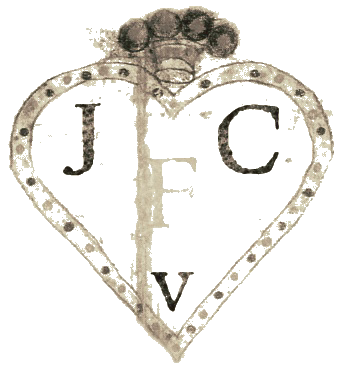|
Duomo
Santa Maria Matricolare/Assunta
Piazza Duomo |
|
This church
has its own page
|
Padre Filippini
San Fermo Minore di BrÓ
Via Filippini |
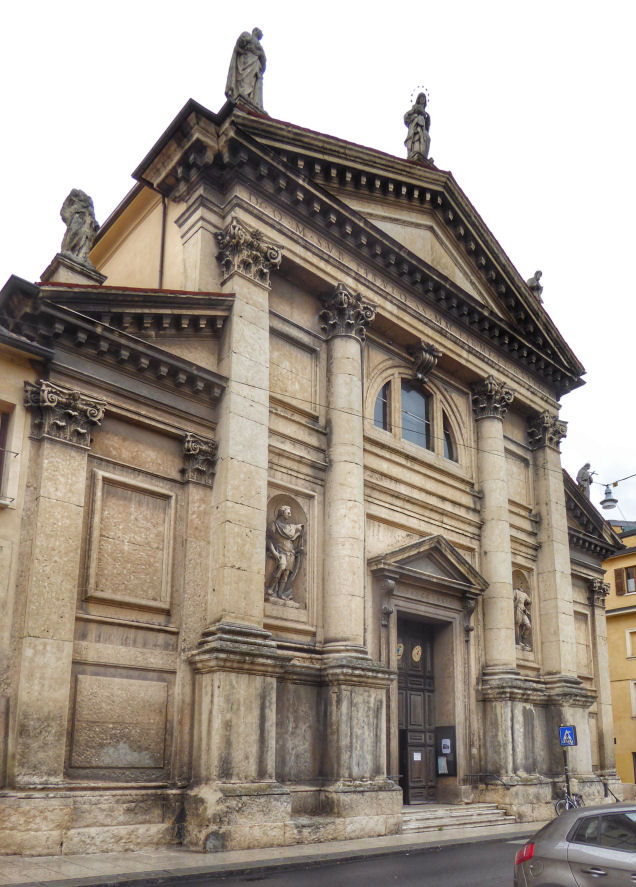 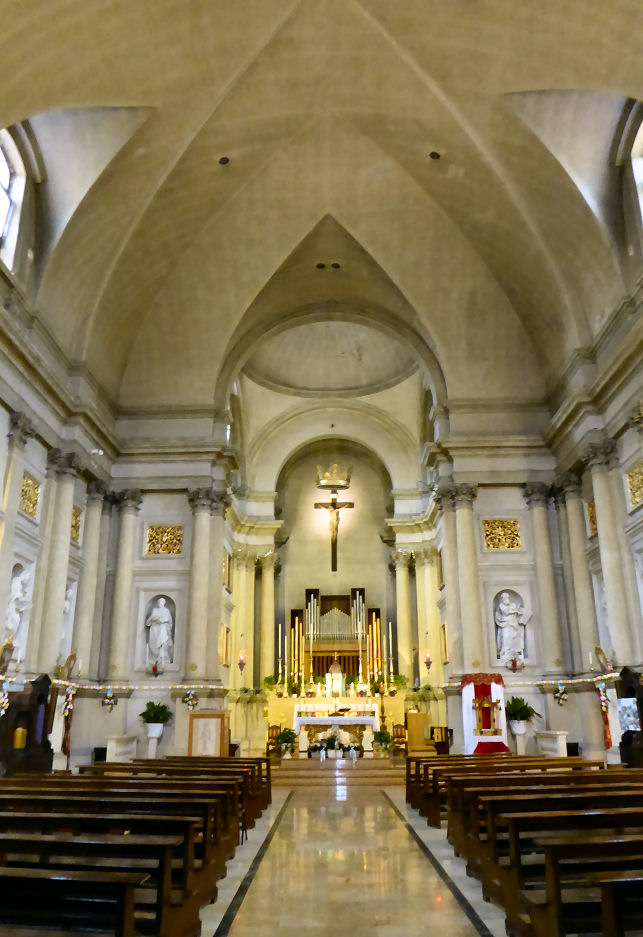
History
Dedicated to the Saints Fermo and Rustico.
Built from 1746, to designs by Andrea Camerata, by the Oratorians, who had found their previous church, San Fermo Minore,
to be becoming too small. Finished by 1791 and decorated with works from the
destroyed San Fermo Minore. The church was heavily damaged during the Second World War
and subsequently rebuilt.
|
|
San
Benedetto al Monte
Vicolo Monte |
|
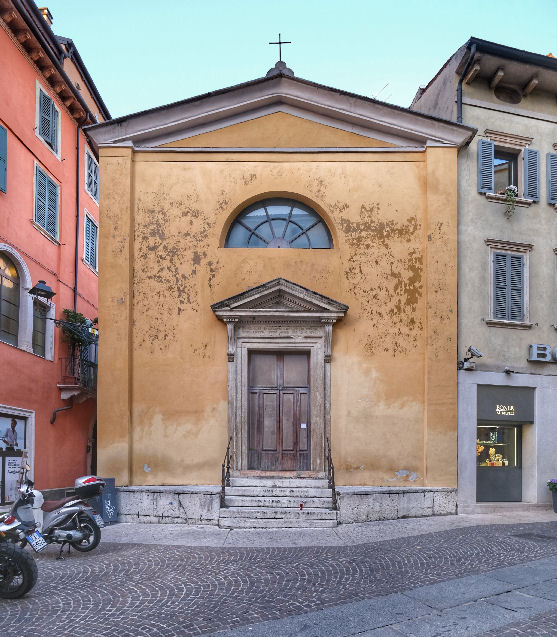 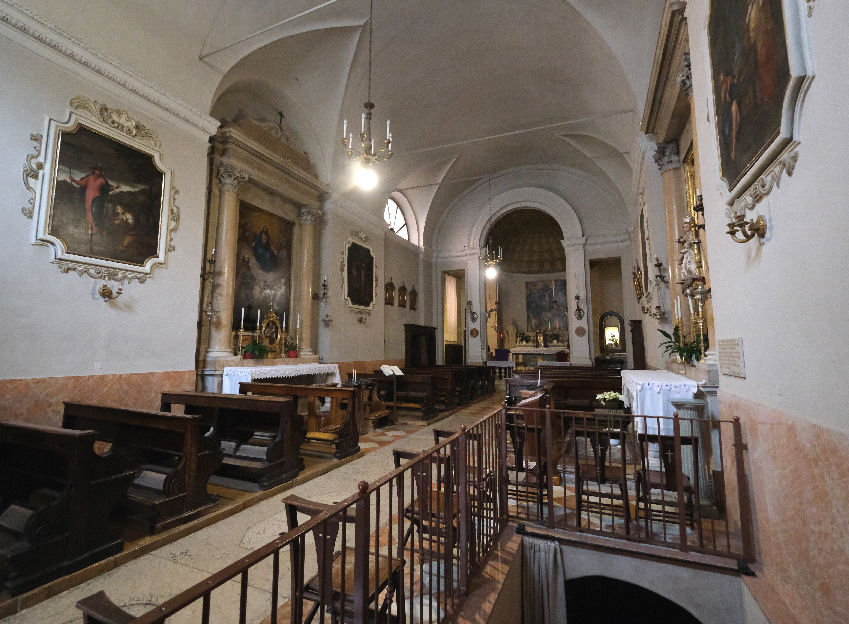
History
Founded by Benedictines from Leno Abbey near Brescia around the end of the
10th century. The crypt is all that survives of this original
building, built up against the foundation of the Roman Capitol, with 9th-century columns and capitals.
This church had three levels, the highest was the monastic church with
stairs down to the level for the laity with access from the churchyard,
the lowest the crypt.
The church was rebuilt in Romanesque
style in the 12th century, probably following the earthquake of 1117. From
1615 to 1617 there was further major rebuilding, during which the pavement
of the plebeian church was raised to that of the monastic level and the
church acquired its current appearance. In 1777/8 the high altar and its
statue of Saint Benedict were renovated, as was the presbytery in
1853.
The name "Monte" is derived from the Monte
di PietÓ opposite the church, a Franciscan charitable organisation. San
Benedetto became a parish church in 1336 but was suppressed by Napoleon in
1805.
Between 2015 and 2017 the crypt underwent archaeological investigations
and restoration, with one of the two staircases restored to provide access
to the crypt from the church. There are fresco traces.
Interior
The aisleless nave precedes a raised presbytery, all covered by a
barrel vault. In the apse is an altarpiece by Jacopo Ligozzi of The
Trinity with Saints Charles Borromeo and Homobonus and fragments
of fresco by the workshop of Giovanni Badile. The nave has one altar each
side.
Opening times
Daily 9.00 - 12.00
A video and visit to the crypt is advertised as taking place on Sundays at
3.30.
|
|
San Bernardino
Stradone Antonio Provolo |
This church has its own page
|
San Domenico
Via del Pontiere |
History
A church and monastery was built here on land bought in 1517 for
Dominican nuns whose complex outside Verona, San Domenico dell'Acqua
Traversa, had been demolished because
the Republic of Venice's insistence on the clearing of land a mile around
the city walls for ease of defence. The major work took place between 1537 and 1543. The nuns
moved in in 1543 and the church was consecrated on November 11th 1554 by
the bishop of Verona Luigi Lippomano. The church was rebuilt at the turn
of the 17th and 18th centuries with the loss of the 16th century fittings.
Suppressed by Napoleon
in 1811 the complex passed into private hands. Initially bought by
Domenico Maboni, it was later, between 1827 and 1831, bought from him by
Leopoldina Naudet, founder of the congregation of the Sisters of the Holy
Family. It then passed to the Municipality of Verona who split it up and
put it to various uses including a technical institute, the HQ of the fire
brigade first, and then of the police.
The complex suffered significant damage during World War II with only the
church and cloister remaining. The church looks pretty derelict but
has been used by Evangelical Lutherans since October 3rd 2010.
The church seems to have recently become known as
San Domenico al Corso and put to cultural uses.
Exterior
The grand stone portal to the street was built during the 17th/18th
century renovations. The statue in the niche is Saint Dominic by
Orazio Marinati.
Interior
Very baroque and colourful, with much painting and marble.
Altars built by Francesco Marchesini during the same rebuilding work.
The vault frescoes feature Dominican subjects by Francesco Marchesini's
son, Alessandro, centred on The Glory of Saint Domenic, with trompe
l'oeil architecture by Antonio Zanoni.
Other artists with work here include the French painter Ludovico Dorigny,
Sante Prunati and his son Michelangelo, Simone Brentana and Odoardo
Perini.
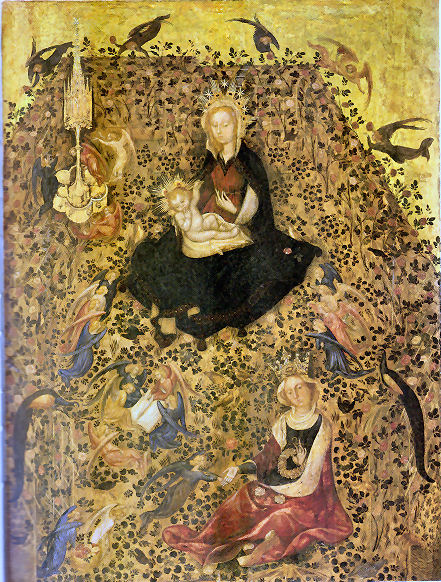
Lost art
The
Castelvecchio's justly famous and luminous Virgin and Child with Saint Catherine,
called the Madonna of the Rose Garden (see right) of
c.1420ľ1435, which has been attributed most recently to Michelino da Besozzo and
previously to Stefano da Verona. Crowe and Cavalcaselle (in A History of Painting in North Italy)
thought that it was by Pisanello. But it should be noted that the painting
includes a peacock which was, according to Vasari, Stefano da Verona's
hallmark (contrassegno).
The Miracle of San Domenico (The Healing of Napoleon Orsini Fallen from
his horse) by Antonio Balestra is also now in the Castelvecchio Museum.
Opening times
A fresh sign with the name and logo of the Sorelle della Sacra
Famiglia on it says Monday, Wednesday and Friday
8.30-1.30
But this was on San Domenico's Facebook page which
hasn't been updated since December 2021, so caution is advised. |
|
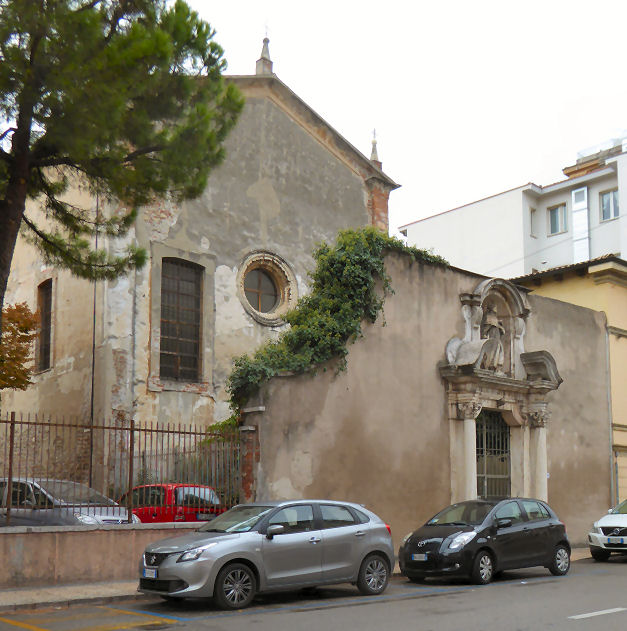
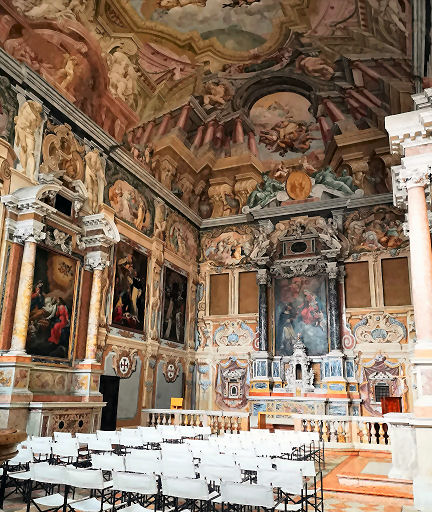
Interior photo from wikipedia by
Stefania Garonzi
|
|
San Fermo
San Fermo Maggiore
Via Dogana |
This church has its own page
|
San Giacomo alla Pigna
Via San Giacomo alla Pigna |
Lost art
A triptych showing the Virgin
and Child Enthroned flanked by Saints Peter and James by the
studio of Antonio Badille II, once over the high altar here, is in the
Castelvecchio, where it's been since 1812. As has a Virgin and Child
with Saints Roch and Sebastian by Girolamo Dai Libri, called The
Mafffei Madonna. |
|
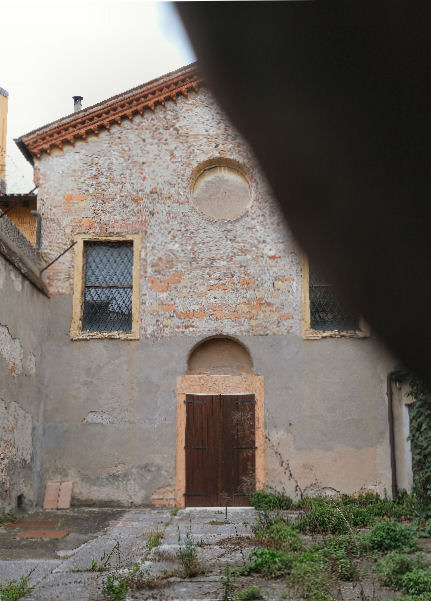
|
San Giorgio in Braida
Piazzetta San Giorgio |
History
A church was first built here in the late 8th century, in a field by
the walls, hence Braida from the Germanic breit
meaning a large clearing. The current church was built from 1477 to designs
by Antonio Ricci. This building was begun by wealthy Venetian monks, the Canons
Regular from
San Giorgio in Alga, who acquired the monastery complex from the Benedictines in
1442. In the mid-16th-century the Venetian mannerist architect Michele Sanmicheli added a
rare-for-Verona dome. He also designed the campanile, actually executed by
Bernardino Brugnoli, who never finished it, and the gate. The
facade was begun later in the 16th century but only finished in the
17th, with the statues of the Saints George and Lorenzo Giustiniani
added in the 18th century.
Interior
A somewhat stern and bare aisleless nave with four deepish chapels each side and a
dome over the crossing, all the work of Sanmicheli from 1536-43. An organ and
choir gallery take the place of transept arms, both supported by four
columns.
The deep
apse has Paolo Veronese's fine much-removed, -damaged and -restored Martyrdom of Saint George over the high altar,
painted in 1566, the same year that he was in Verona to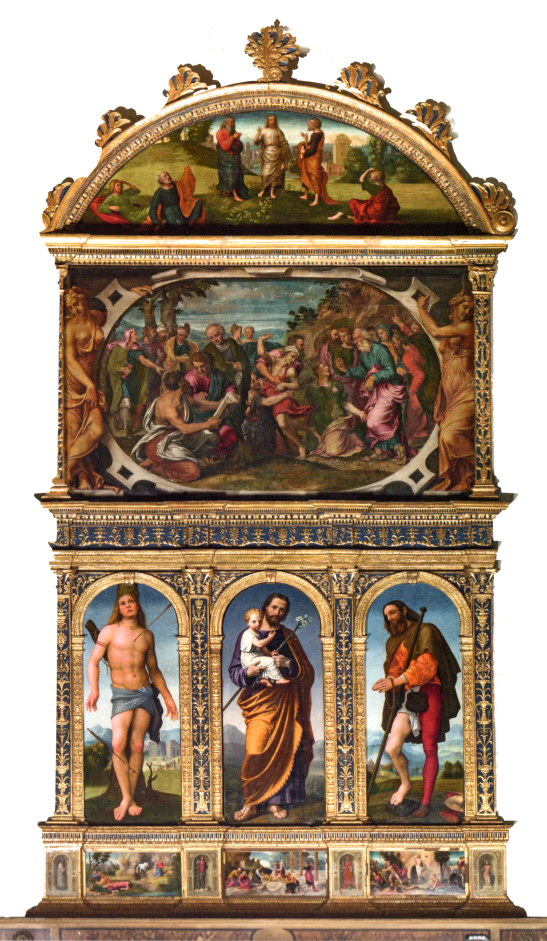 marry Elena Badile. The altar itself was
designed by Bernardino Brugnoli, a nephew of Sanmicheli, although some
sources attribute it to Sanmicheli himself. On the left of the apse
is Manna by Felice Brusasorci, on the right The Multiplication
of the Loaves is a late work by by Paolo Farinati. Both are a bit forgettable and were
completed by the pupils Alessandro Turchi and Pasquale Ottino. Either side
of the arch is a pair of canvases, once organ shutters, of the Annunciation
by Giovanni Caroto from c.1508,
he being the younger brother of the more famous Giovan Francesco. marry Elena Badile. The altar itself was
designed by Bernardino Brugnoli, a nephew of Sanmicheli, although some
sources attribute it to Sanmicheli himself. On the left of the apse
is Manna by Felice Brusasorci, on the right The Multiplication
of the Loaves is a late work by by Paolo Farinati. Both are a bit forgettable and were
completed by the pupils Alessandro Turchi and Pasquale Ottino. Either side
of the arch is a pair of canvases, once organ shutters, of the Annunciation
by Giovanni Caroto from c.1508,
he being the younger brother of the more famous Giovan Francesco.
Some very fine altarpieces in the nave,
though, once admired by Goethe and lit by red buttons by the label
stands. The first chapel on the left has Saint Ursula and the 11
Thousand Virgins
(1545) by Giovan Francesco Caroto, the second has a Martyrdom of Saint Lawrence
(1583) by Sigismono de Stefani.
The polyptych in the third (see
right) is from c.1510/15 with
admirable paintings of the plague saints Roch and Sebastian
by Giovan Battista Caroto.
The soppy central panel of Saint Joseph and the Christ Child
(1882) is by someone named Recchia and covers a fresco of the 14th century
of Christ Carrying the Cross which was said to have miraculous
powers but had become damaged. There's a crowning lunette panel of The
Transfiguration and a large later (1545) oval painting of
Apostles Trying to Exorcise a Demon from a Possessed Boy by Domenico Brusasorci,
a pupil of Caroto.
The wide predella panels, by Caroto, depict The Agony in the Garden,
The Deposition
and The Resurrection, with the pilasters between these panels
having figures important to the Canons Regular.
A highlight is the
Virgin and Child Enthroned between Saints Zeno and Lorenzo Giustiniani of 1526 in the next one (also known as the Madonna della Cintura)
(see below right), by Girolamo dai Libri, which is
decidedly Bellini-ish with another Domenico Brusasorci
lunette above, this time of God the Father.
Above the main door is a
an unusually simple and orangey Baptism of Christ by Tintoretto. There's
also a Pentecost by
Domenico Tintoretto, his son, over the third altar on the right. A
Virgin with the Three Archangels and Tobias by Felice Brusasorci is in
the next one.
Lost art
An enormous stage-set-like Crucifixion of 1501 painted for the refectory
here by Michele da Verona is now in the Brera. The coat of arms at upper
right suggests that it was commissioned by Niccol˛ Orsini. A smaller
version, dated 28th March 1505, was painted for the church of Santa Maria
in Vanzo in Verona, both being commissioned by the Secular Canons of the
Blessed Lorenzo Giustiniani.
Paolo Veroneseĺs Miracle of
Saint Barnabas is a rare depiction of a narrative of this apostle,
showing him healing the sick in Cyprus by touching them with a book of the
Gospel of Saint Matthew. This altarpiece was looted from this church by the French in 1797, as was
his Martyrdom of Saint George. The Saint George was returned in
1815 but Saint Barnabas was not and is now in a gallery in Rouen.
There's a copy here under the choir gallery.
Nearby shrapnel
The 1791 rectory attached to the church still has bullet holes
from October 1805 from the fighting between the French and Austrian troops
occupying opposite banks of the Adige.
Opening times
A group called Verona Minor
Hierusalem staffs touristic visit times for this church, and
four more nearby. The times they publicise for this church are
Thursday, Friday, Saturday 10.00 - 5.30
Sunday 1.00 - 5.30
I assume that the church will be open at other times too.
|
|
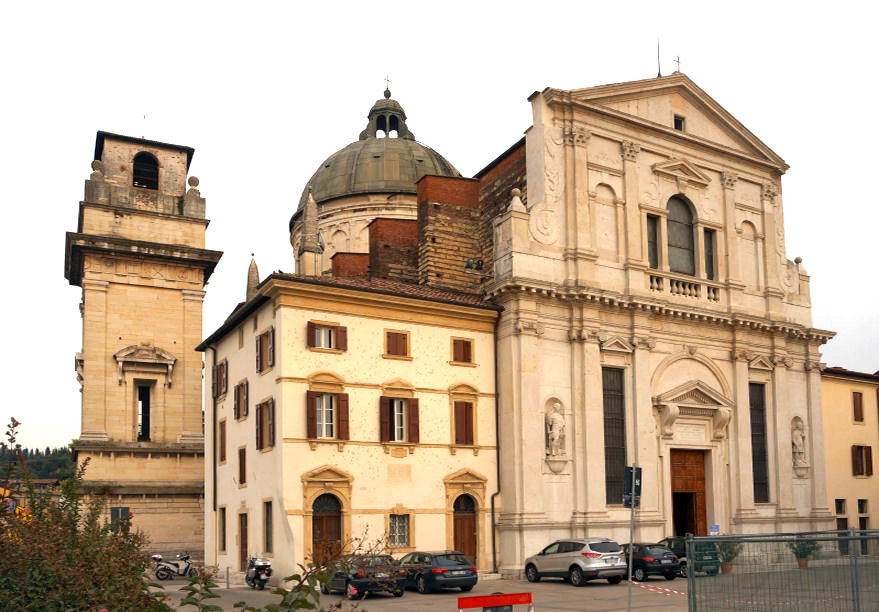
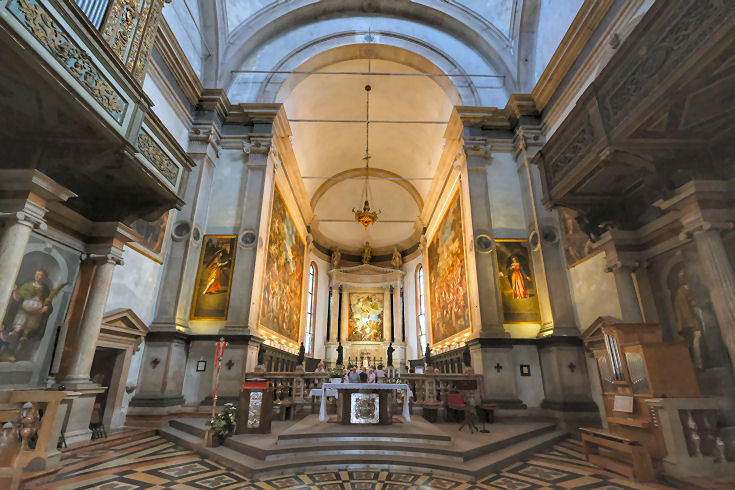
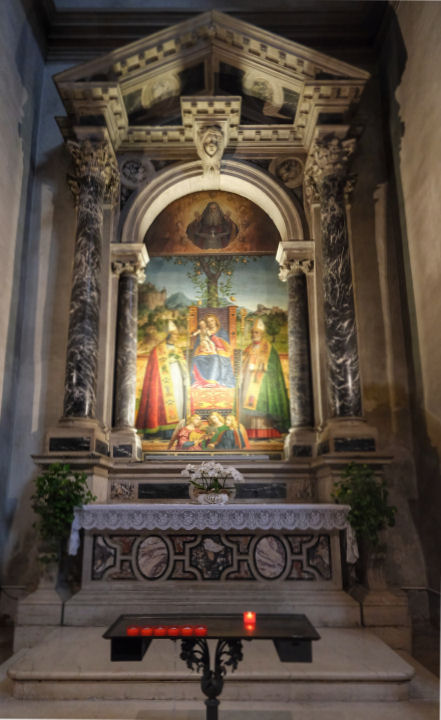
|
|
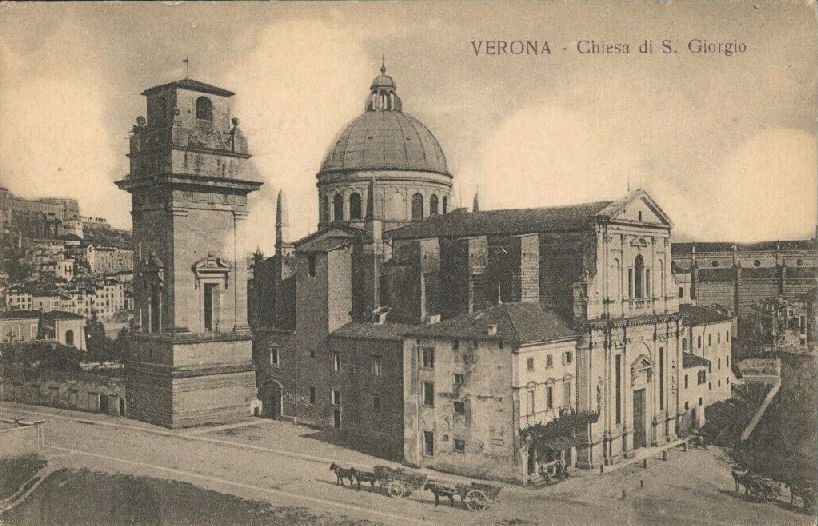 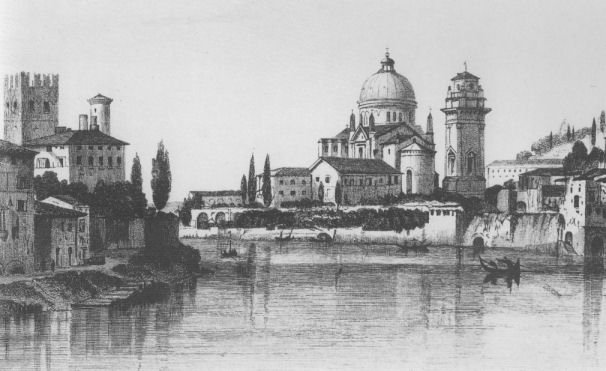
The church in the 19th century.
|
|
San Giovanni in Foro
Corso Porta Borsari |
|
History
Originally built on the main Roman road, now the Corso Porta Borsari,
opposite the Forum, hence in Foro. The first written evidence of the church dates
from 959.
This church was
heavily damaged during the fire of 1172 and rebuilt in Romanesque style. During
restoration work on the campanile in 1902 charred remains of crenulations
and arrow slits were found, suggesting that the tower had been converted from an older defensive tower.
A few years later plaster falling from the outside walls revealed the
brick and pebble banding and later removal of interior plaster revealed
14th century frescoes. San Giovanni served as a parish church during the
medieval period.
Exterior
The renaissance doorway bears the name of the donor, Benedetto Rizoni,
a prelate and commentator on the scriptures, and his arms, featuring a
hedgehog rampant. It is topped by sculpted figures by Girolamo Giolfino of Saints John the Evangelist (in the centre), Peter, and
John the
Baptist/Paul? to left and right. The fresco in the lunette of St John the Evangelist on
Patmos is by Nicol˛ Giolfino, Girolamo's nephew. Between the two large
windows in a square niche is a very weathered fresco of The
Deposition by Domenico
Brusasorci.
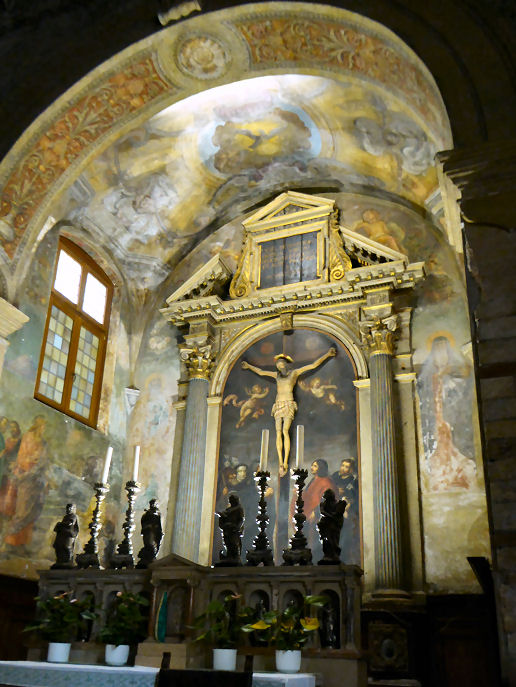
Interior
An aisleless space with a timber roof and two chapels on the left. In
decoration one is very modern, but with an impressive timber coffered
ceiling, and one is very baroque.
Opposite then there is a miniscule crib made by the
soldiers here during Christmas 1917 when the church was being used as a
military hospital.
Over the high altar the Crucifixion by an 18th
century artist called Giovan Battista Rossi (called Gobbino)
features the Virgin, St. John the Evangelist, St. Dominic of Padua
(probably added posthumously) and a weeping figure thought to be the
commissioner of the work. Frescoes either side depict the prophets Isaiah
(left) and Jeremiah.
The interior has undergone much baroque-era and later renovation.
Four red
marble columns support a women's gallery at the back, now bricked up, but
hung with paintings by Antonio Giarola (The Virgin and Child with
Saints Sebastian and John the Evangelist, in the centre) and Claudio Ridolfi (The
Virgin and Child and The Guardian Angel, to either side).
Frescoes include a very pale and damaged 14th century Virgin Lactans with Saints John
the Baptist and John the Evangelist.
On the left wall between the chapels is a Virgin and Child
sculpture of the 13th century signed by Maestro Pulia, court artist and sculptor
to the Scala family.
Opening times
Daily 9.30-12.00 & 3.00-7.00
A group called Verona Minor
Hierusalem staffs touristic visit times for this church, and
more nearby. The times they publicise for this church are
Saturday 10.00 - 5.30
|
|
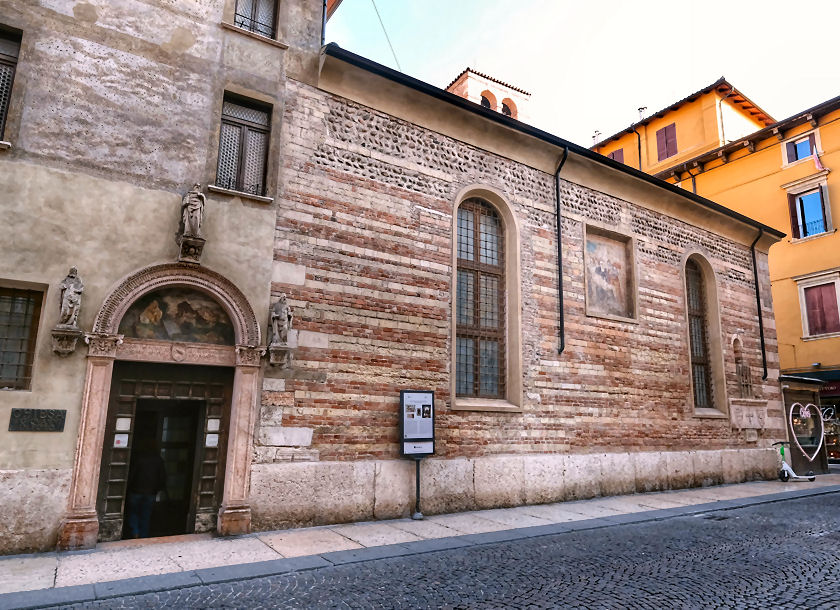
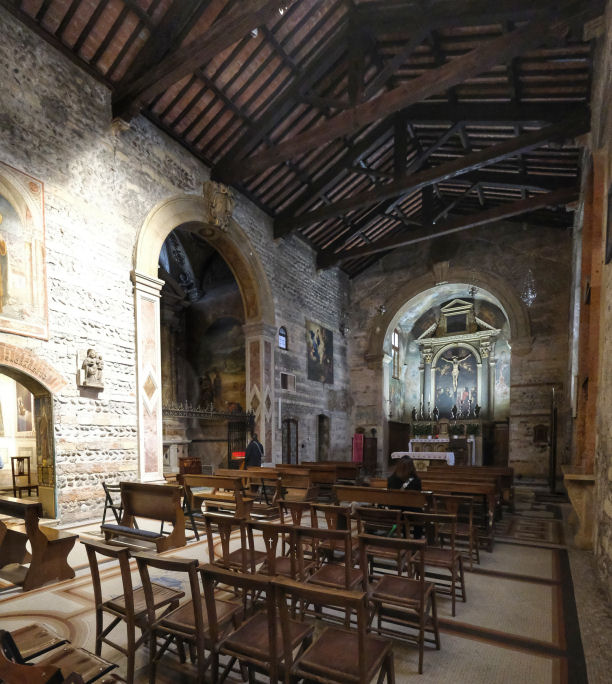 |
|
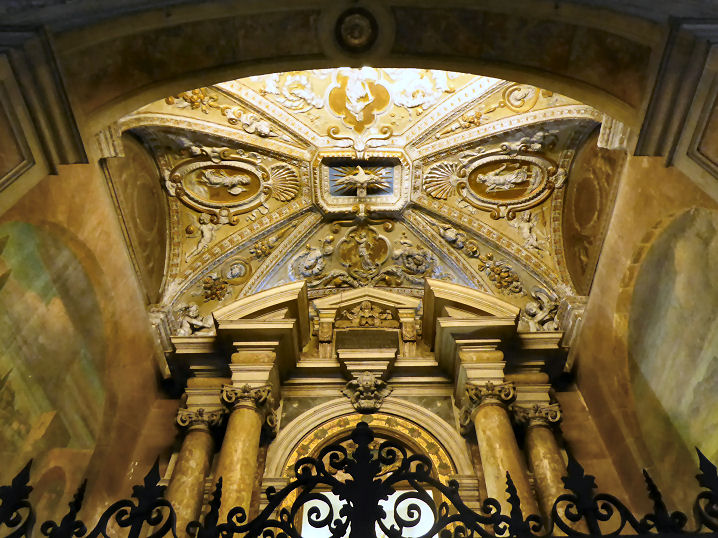
|
|
San Giovanni in Valle
Via San Giovanni in Valle |
History
Founded in the 8th century, with some conjecture taking the
date of building back to the 4th century, the original church was built on
the site of an ancient pagan cemetery and a Roman temple. Remains of this
first church survive as part of the current crypt. Rebuilding after destruction
during the 1117 earthquake resulted it the current Romanesque church,
consecrated by Ognibene, the bishop of Verona, in 1164. The fašade was originally where the first pair of pilasters
are now, but it was rebuilt one bay to the west. as can be seen by the
wall surface, in the 14th century, after the Council of Trent, to make an area
for the unbaptised. Badly bombed in 1944, on the night of the 10th of
October, by a direct hit to the nave, damaging the church's
13th and 14th century frescos and killing and injuring people sheltering
in the crypt. Restoration work followed, with the opportunity taken to
restore the small windows in Romanesque style and remove the larger 17th
century windows. The 15th century front doorway and porch has
The Virgin and Child with Saints Bartholomew and Anthony Abbot, a fresco by
Stefano da Zevio in the lunette.
Interior
A long tall narrow nave on two
levels with two aisles divided by slim marble columns alternating with
stout pilasters. The floor is 19th century. The raised presbytery sits over the crypt and originally
had no staircases, being a separate area for the high timber ceiling with a considerable
exposed brick
and a pale stone. A clerestory level with three small windows one side and some
fresco bits on the other. Later decoration in the last two pairs of arches before
altar.
Layers of early fresco which evidently appeared from under
whitewash in late 19th/early 20th century on the right wall of the raised
presbytery area, the oldest looking very Byzantine (see photo below).
The walls here would have once been entirely covered in frescoes.
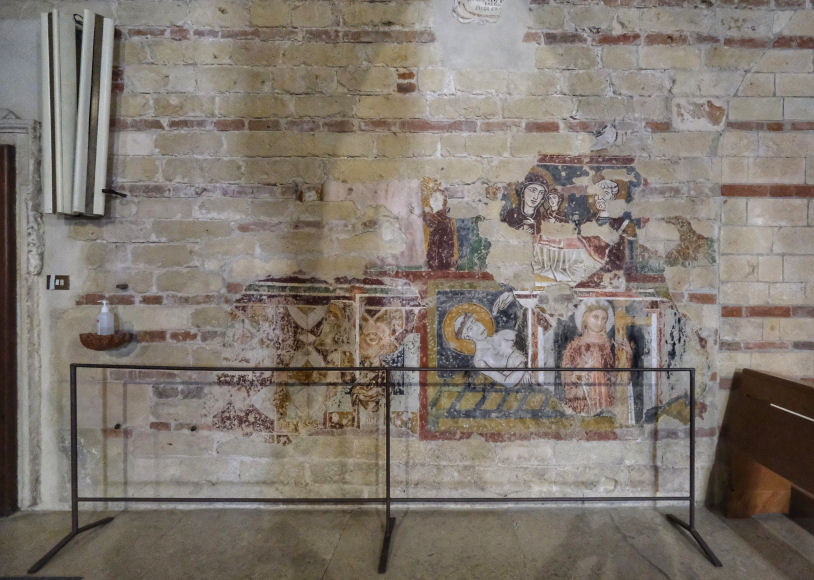
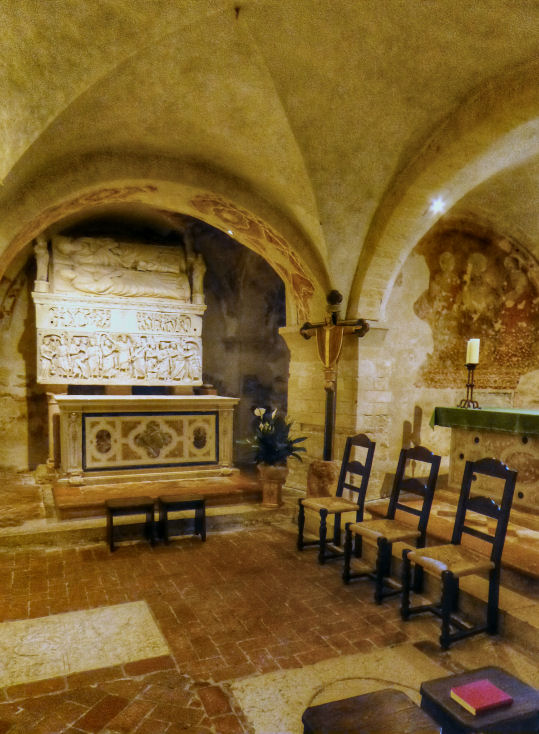 The crypt The crypt
To be found under the raised presbytery. The remains of the 9th
century church are towards the front, with the rear in
Romanesque style and dating to the 12th. Damaged frescoes on the right
wall.
The polychrome marble altar is 16th-century.
Also down here are a pair of early Christian sarcophagi, probably
from the cemetery the church was built upon. The one on
the left (see photo right) is 4th century and said
to contain
the relics of Saints Jude and Simon and has carved reliefs on three sides
with stories from the Old and New Testaments, in the upper and lower
registers respectively. The lid, sloping with Saints Simon and Judas
depicted is not original but was installed in 1395 with the claimed
discovery of the relics of the two saints. The other is 2nd or 3rd
century, may be Roman, and has busts of a husband and wife in a shell in the centre
as well as figures of philosophers at the corners later transformed into Saints Peter and Paul.
Fragmentary frescos in the chapels down here too.
Campanile
Romanesque below, with Roman stones used, and renaissance above, with
mullioned windows. Five bells by Cavadini from the 19th
century.
Cloister
Romanesque. Only one wing remains (see photo below) with the
rectory in the courtyard, also very old, probably contemporary with the
church.
Local artist
The first record of the life of Liberale da Verona is in the census of
1455 for the neighbourhood of this church.
Opening times
A group called
Verona Minor Hierusalem
staffs touristic visit times for this church, and
four more nearby. The times they publicise for this church are
Thursday, Friday, Saturday 10.00 - 5.30
Sunday 12.00 - 5.30
These are the Visite Turistiche times posted on an A4 sheet
just inside the gate too.
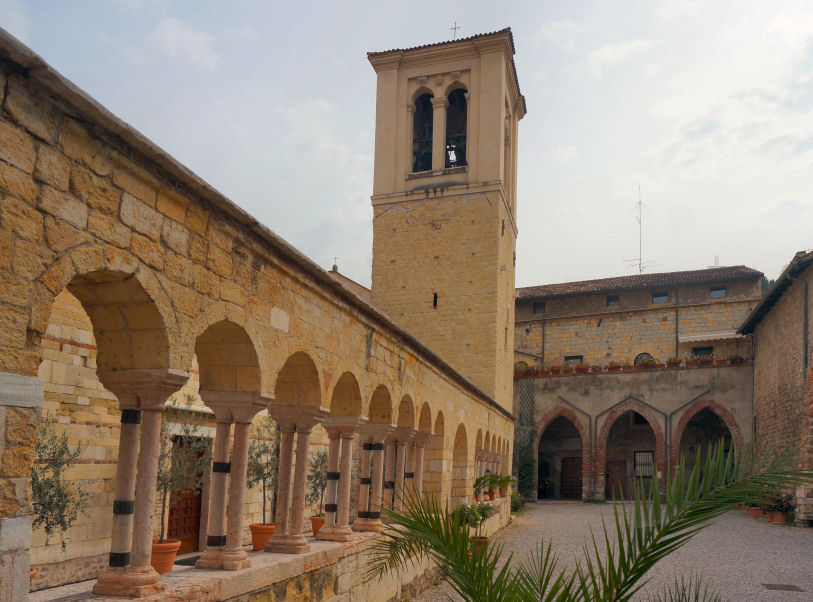
|
|
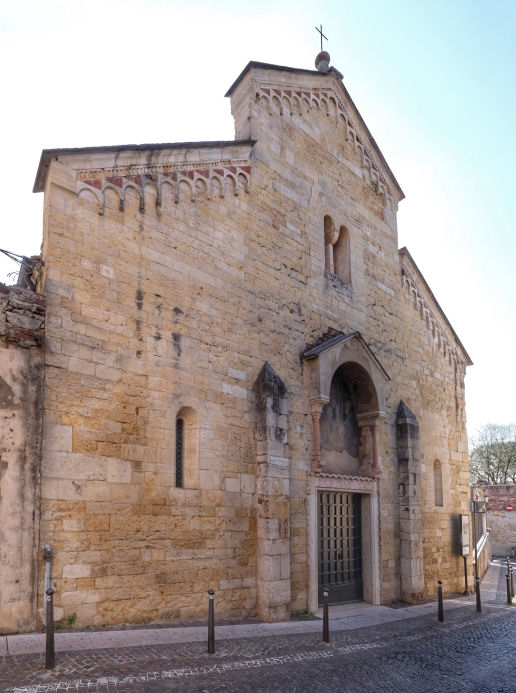
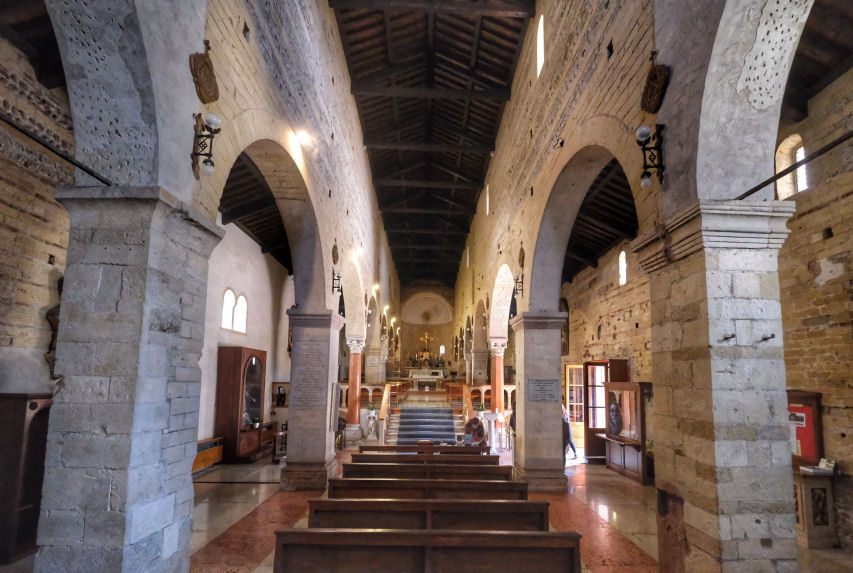
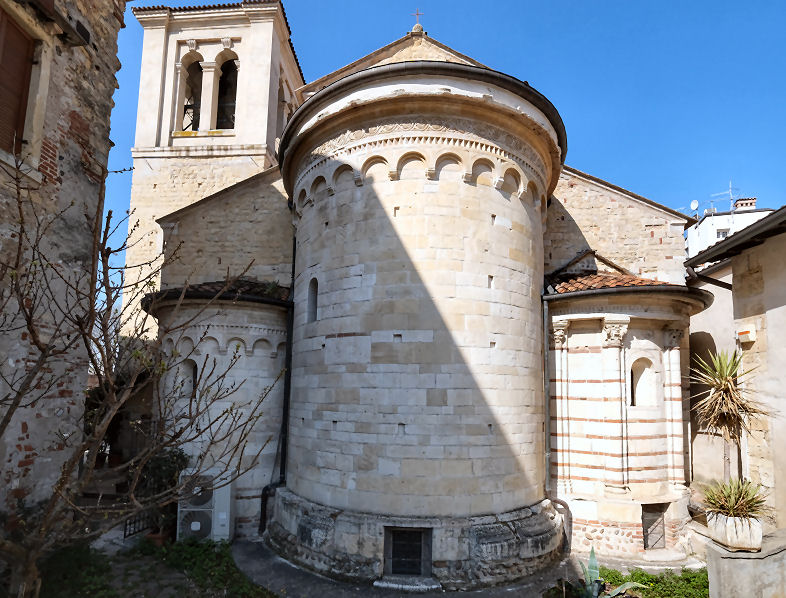
The apse end showing remains of the old church
around the base. The one on the right with the pilasters is reckoned to be
the oldest, by a few years.
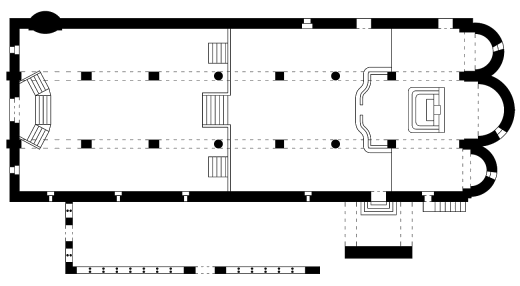 |
|
San Girolamo |
History
In the Roman Theatre complex, now part of the Archaeological Museum, along
with the complex's refectory (where fragments of fresco remain) and cloisters. built by the Jesuits in 1492. Following a series of sales, the building came to one Giovanni Bertani,
who rebuilt it in 1838 in its present form.
Interior
A small church with a ceiling of painted wooden panels, now used
to display patches of mosaic flooring as part of the Museo Archeologico al
Teatro Romano.
Art
The Annunciation fresco over the apse arch is an early work by Giovan Francesco Caroto,
signed and dated 1508. They were painted after he had spent some time
in Milan, which may explain the Leonardo look to them. In the underside of the apse arch, frescoed 1465 under Domenico Morone's
direction, the Four Evangelists are 'obviously by the hand of Liberale da
Verona' Inside the apse are four lunettes and a window - Christ
is flanked by Saint Peter and Saint Paul, and to the right
is Saint Jerome. Over the altar is a panel depicting Saint
Jerome of 1578 by Paolo Farinati.
|
|
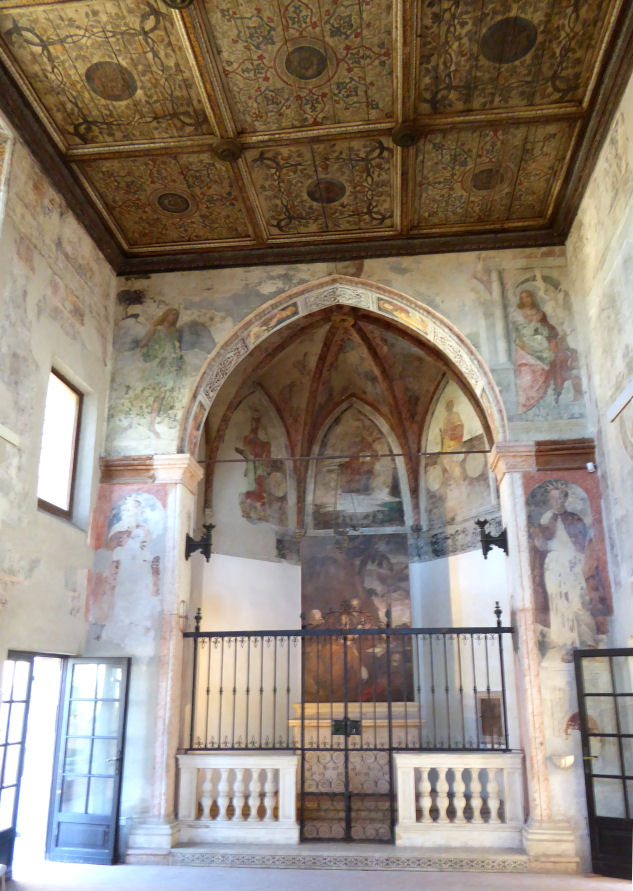
|
|
San
Lorenzo
Corso Cavour |
History
The original Roman basilica on this site (supposedly dedicated to
Venus) was built in the 5th century and restored in the late 8th. The current church
was built around 1110, and it is suggested that Lanfranc of Modena, the
architect credited with that city's famed cathedral, was responsible.
There was
more work after 1117, after the earthquake, and considerably enlargement
shortly after that. The pre- and post-earthquake phases are visible on the
outside as the alternating bands of pebbles with brick and stone in the
lower level give way to just bricks and stone above the lower windows.
Extensive restoration in 1877 to return it to its former glory.
Exterior
From the street you get to the church through a 15th century archway,
with a statue of Saint Lawrence above, clutching his gridiron
attribute, into a small courtyard containing decorative fragments from the
original early Christian basilica. The church's exterior has the
characteristic
Veronese Romanesque banding of brick and tufa. The porch and the
campanile also date to the late 15th century. The pair of cylindrical
towers either side of the (somewhat hemmed in) fašade contain spiral
staircases used to access the matronea, or women's gallery.
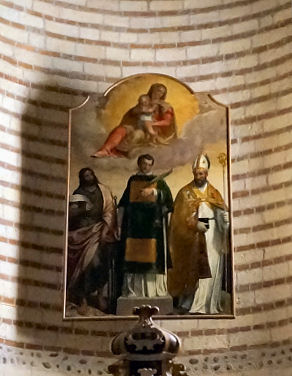 Interior Interior
An atmospheric and impressive Romanesque interior, very tall with four very stout cruciform piers alternating with four unmatching
marble columns which divide the the tall aisles from the looming nave with
a wooden roof.
There's a simple semi-circular apse and galleries for women (which
were divided into separate spaces for virgins, widows and matrons) around
the sides and back, with chapels where the transept arms would be and
larger gallery spaces above them. Open chapels on either side of the apse
with some of the church's characteristic small and sparse 13th century
fresco fragments.
Art highlights
Above the high altar - a Virgin and Child with Saints John the
Baptist, Lawrence and Augustine (see left) by Domenico Brusasorci of 1566.
Campanile
Romanesque, built in 1486.
Opening times
Weekdays 9.00 - 12.00, 3.00-5.00
Sundays and holidays 3.00 - 6.00
A group called Verona Minor
Hierusalem staffs touristic visit times for this church, and
four more nearby. The times they publicise for this church are
Saturday 10.00 - 5.30
|
|
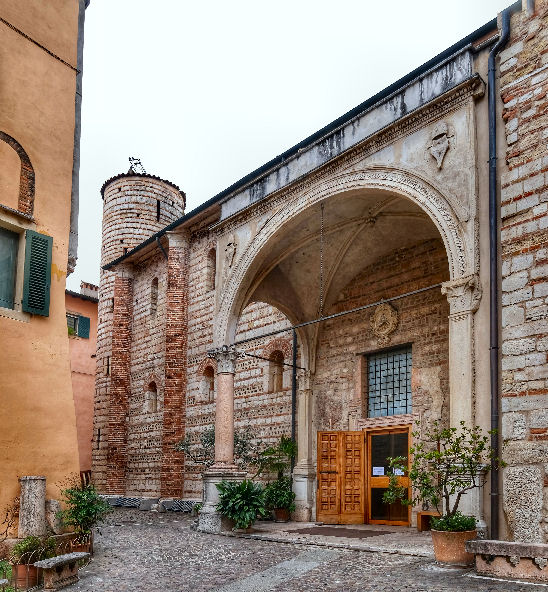
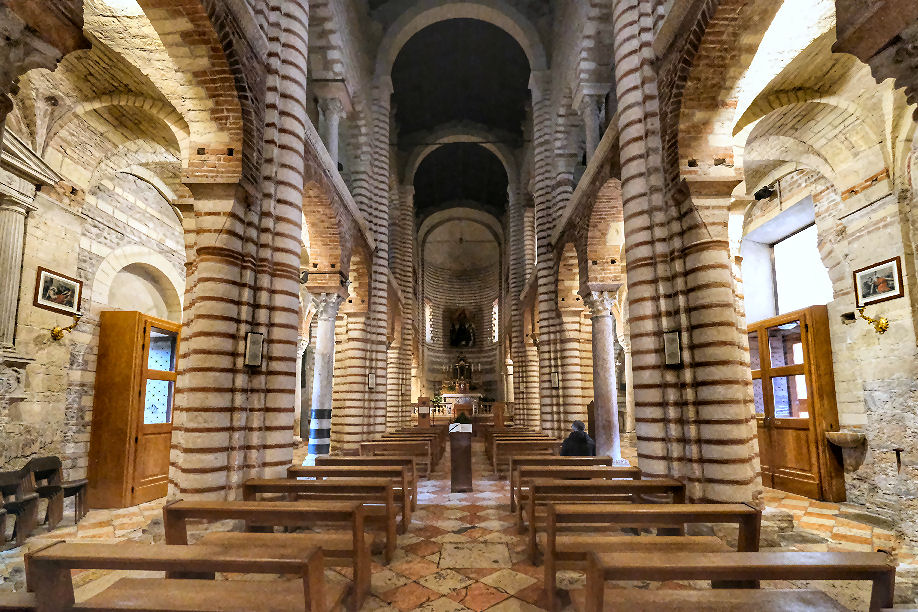
|
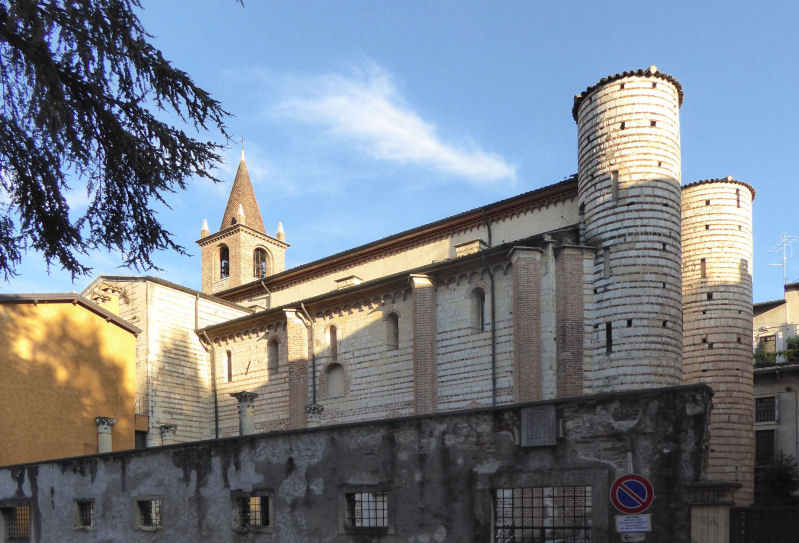
|
San Luca
Corso Porta Nuova |
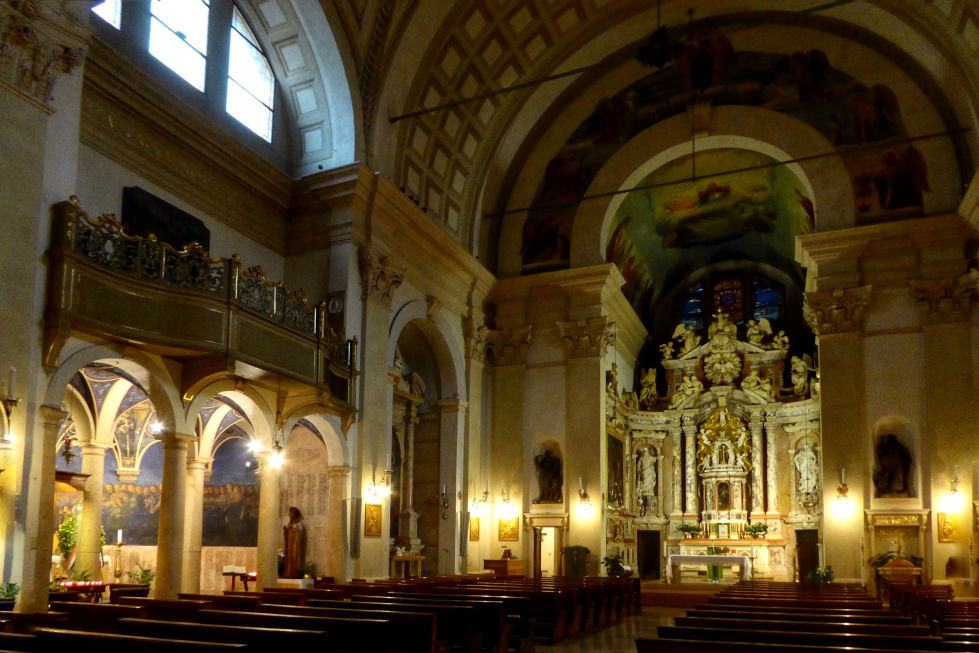 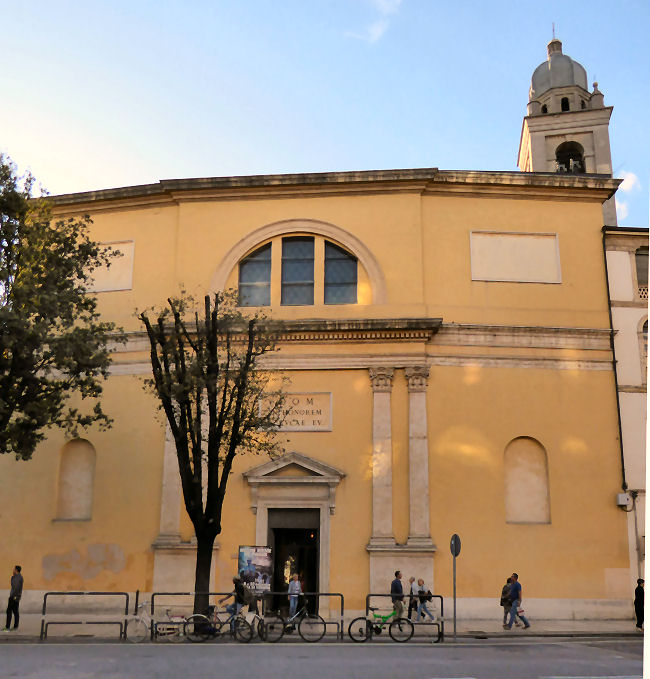
History
The original church on this site was built in 1172 by the
Cavalieri Crociferi (Knights of the Crucifix). This Order was abolished in
1656 by Pope Alexander III. In March 1657 the church passed to the
Compagnia del Santissimo Sacramento (Society of the Most Holy Sacrament).
Major rebuilding followed - the fašade in1675 and the high
altar in 1691. Expansion from 1753 to reconsecration in 1755. The
Compagnia were suppressed by Napoleon in 1807 and in 1808 San Luca
became a parish church, appointing San Silvestro and Ognissanti. More work
in the 19th century, as a result of road widening, in 1874, the altar
dedicated to Saint Luke was demolished . Only the exterior right side of
the church is now visible, due to building around the church.
Art
Mostly 18th century and later but there's an unusual large
frescoed chapel dedicated to The Fallen on the left.
Campanile
Dates to 1760, new bells installed in the 19th century.
Opening times
Daily 8.00 - 5.00
|
|
San Matteo Concortine
Vicolo San Matteo |
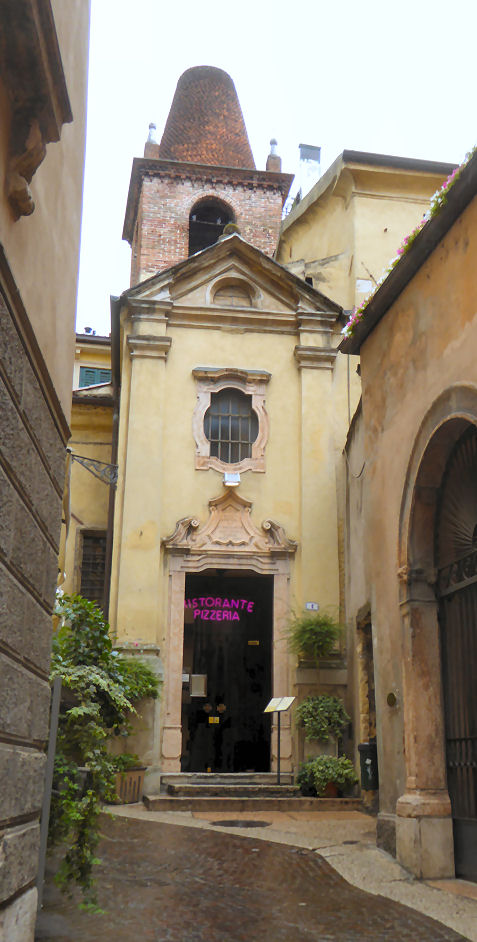 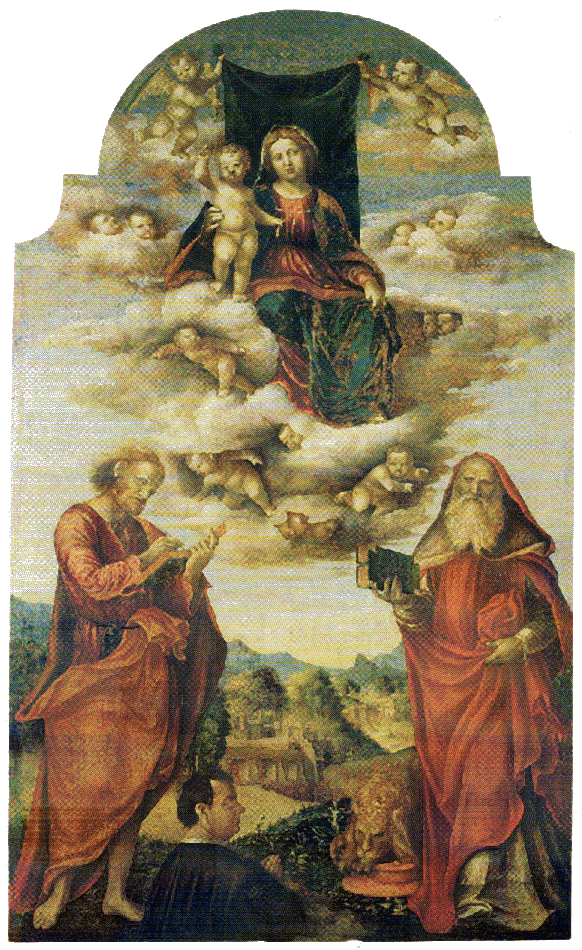
History
A church, built over a temple to the Roman god Giano (Janus),
was first
mentioned in a document of 1105 when part of the church was given to the
abbey of Pomposa. Restoration work in the 18th century was followed by
suppression in 1860. Used during the WW2 as a military warehouse, laundry and
later as a carpenters' workshop.
Now a pizza restaurant.
Through a glass
panel in the floor the remains of the ancient temple of Janus can still be
seen.
Lost art
A panel depicting the Mystic Marriage of Saint Catherine
by the Studio of Antonio Badile II and
a Virgin and Child in Glory with Saints Matthew and Jerome and a donor,
called the Madonna de' Caliari, by Nicola Giolfino (see right), from c. 1530, have both been in
the Castelvecchio since 1812. The latter was the high altarpiece and
features Jerome in his anachronistic cardinal's red robes and hat, not
instigated until 700 years after his death.
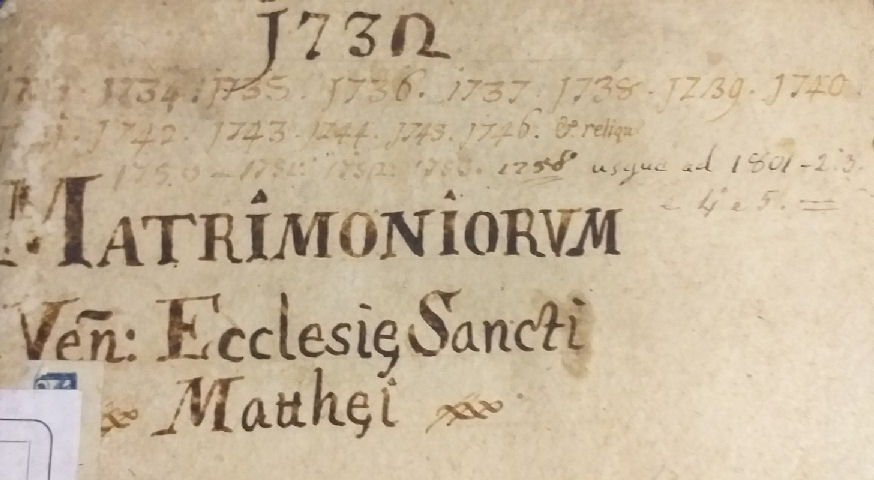
|
|
San
Nicol˛
San
Nicol˛ all'Arena
Piazza San Nicol˛ |
|
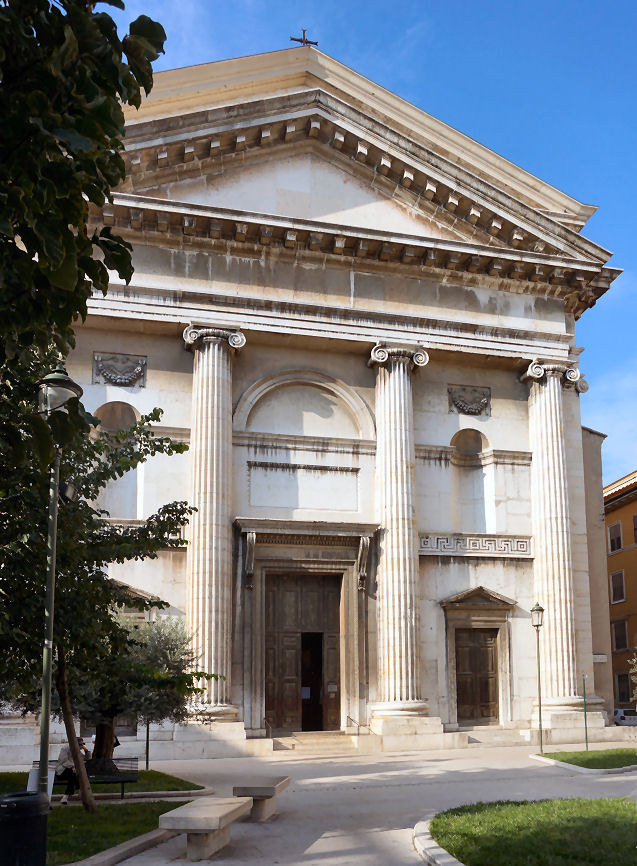
History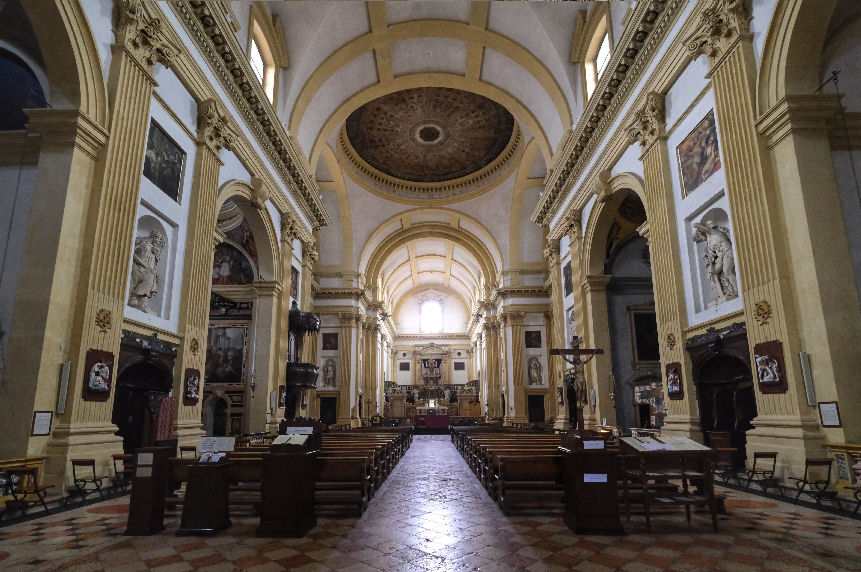
Large and baroque and built from 1627 to plans by Lelio Pellesina on
the site of a previous Romanesque church dedicated to the same saint from
at least as early as the 12th century and called San Nicholai de
Buchadarena. All
that remains of the old church is the crypt under the apse. It is said to
have been a parish church by 1336, but was acquired by the Theatines in
1598, who had resided in the convent of Santa Maria della Ghiara since
1591. A new church
and convent was built for the order with work beginning on 21st March 1627,
to designs by Lellio Pellesina, initially
involving enlarging the already-existing church and changing its
orientation. It
progressed slowly for the next two years when work stopped due the plague
of 1630. Work resumed later, with new funds leading to the completion of two side
chapels and the sacristy. But funds ran out before the dome, campanile and
facade were built. The interior decoration was finished and on 27th May
1697 Bishop Pietro Leoni consecrated the church. With the Napoleonic
suppressions of 1806 the order was ejected and the church returned to
parish use. The
convent complex housed a barracks and then a school.
Exterior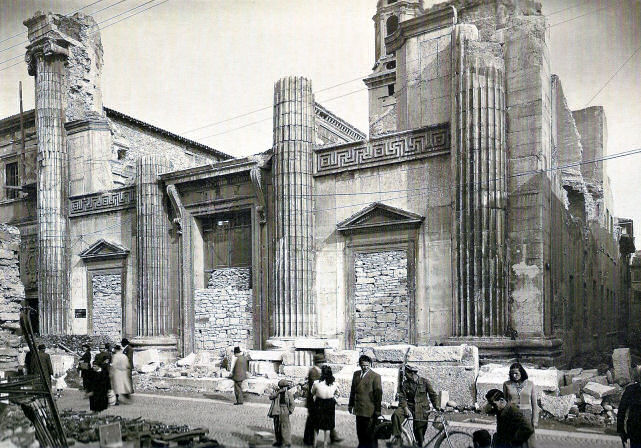
The church's fašade remained incomplete until an 18th century neo-classical facade
was grafted on in 1951 by Pietro Gazzola. It was taken from the church of San Sebastiano,
which was all but destroyed by bombing during WW2 and which stood where the
unlovable late-1970s Biblioteca Civica (city library) by Pier Luigi Nervi
now stands.
Interior
A
pleasingly proportioned and airy space - low-key Baroque with no
aisles but four domed chapels, a deep presbytery and a transept topped by a trompe l'oeil
dome, as the planned dome never built. The Baroque high altar was built by
the Theatine architect and philosopher Guarino Guarini after the plague
of 1630. Tasteful modern stained glass, but no great art, by the 17th
century likes of Antonio Balestra (Saint John the Baptist in the Desert,
first chapel on right), Mattia Preti (Saints
Gaetano (the founder of the Theatines) and Andrew Avellino (a later
Theatine Saint) second
chapel on left) and Alessandro Turchi (also known as Orbetto) (Annunciation
with Saints Joseph, John the Baptist and the blessed Marinoni (the
last is a local Theatine almost-saint of the 16th century and spiritual
advisor to the aforementioned Andrew Avellino) on the right in the chancel).
Lost art
Seven fresco fragments from the monastery here, by Nicola Giolfino, showing
female allegorical figures, have been in the Castelvecchio since their
removal in 1873.
Opening times
Daily 7.00 - 5.30 (closed Tuesday afternoon)
The church of San Sebastiano
in 1946 before its fašade was removed and attached to San Nicol˛.
|
|
Church of
the Stigmata
Via Carlo Montanari |
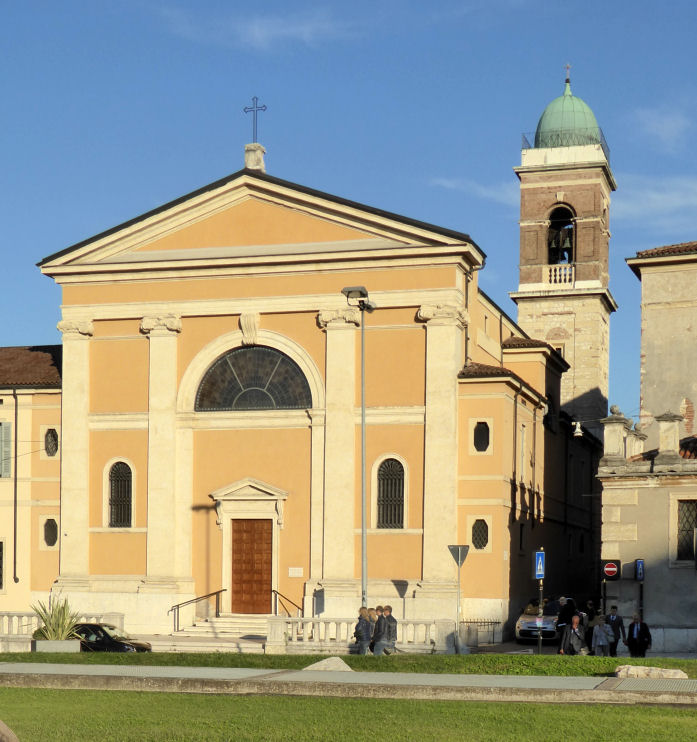 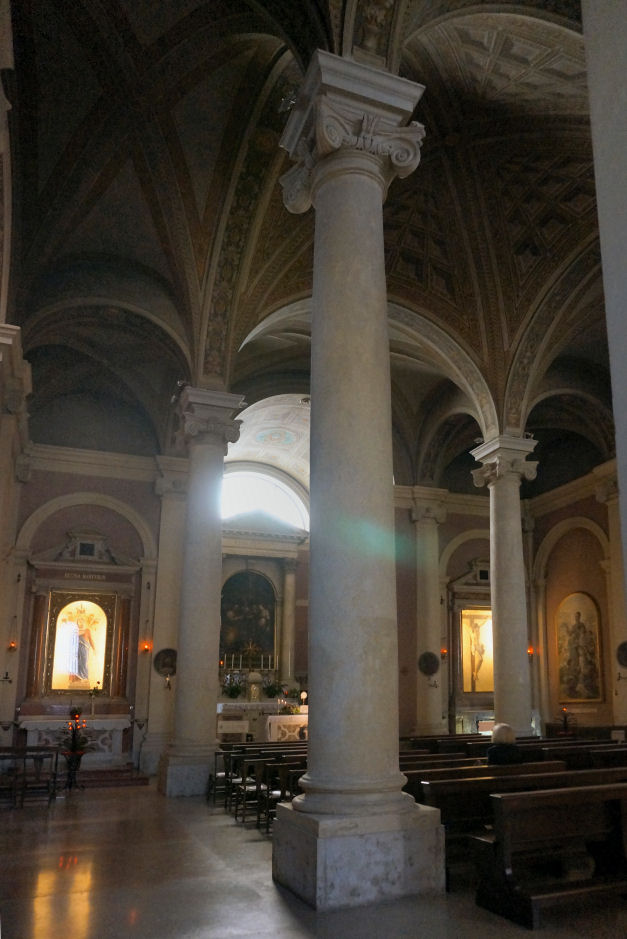
History
In 1816, following suppression by Napoleon, the complex (including the
old church of San Francesco) was taken over by
Gaspar Bertoni, a local priest and (later) saint who was baptised in San
Paolo in Campo Marzio (see the entry below). He established a school
here and later founded the
Congregation of the Sacred Stigmata, later known
as the Stigmatines.
Interior
Short but wide with two pairs of chunky columns dividing the nave from the
wide aisles. A nicely-done painted ceiling.
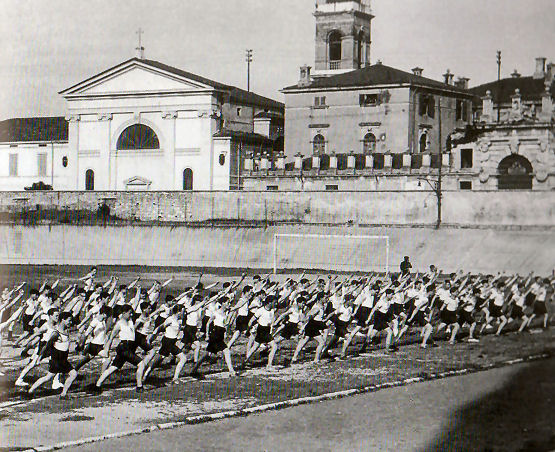
Gymnastics in the Stadium Comunale 1931.
|
|
San Paolo
in Campo Marzio
Via dell'Artigliere |
History
A Romanesque church dedicated to Saints Peter and Paul was built here in
the late 11th century. In 1183 rebuilding began, probably due to damage
sustained during the earthquake of January 3, 1117. Run by secular priests
until 1232 when it passed to the Order of the Umiliati. More work in
1289, when the Umiliati are thought to have left, during which a campanile
was built. Count Alessandro Pompei, an architect and scholar of
ancient Veronese art, directed later rebuilding between 1740 and
1768.
Gaspar Bertoni was baptised here on October 10th 1777 - he went on
to found the Congregation of the Sacred Stigmata (Stigmatines) in Verona
(see the entry above) and was canonised in 1989. There is a plaque in
the baptistery here celebrating his 200th birthday.
On January 4 1945 allied bombing gutted the church, but the most
important works of art were saved by having been removed and placed in
shelters. The church was rebuilt by 1950, recreating the style of
the 18th century rebuilding.
Interior
Wide, pale and boxy inside - even the square
chancel has a flat back. A single nave with three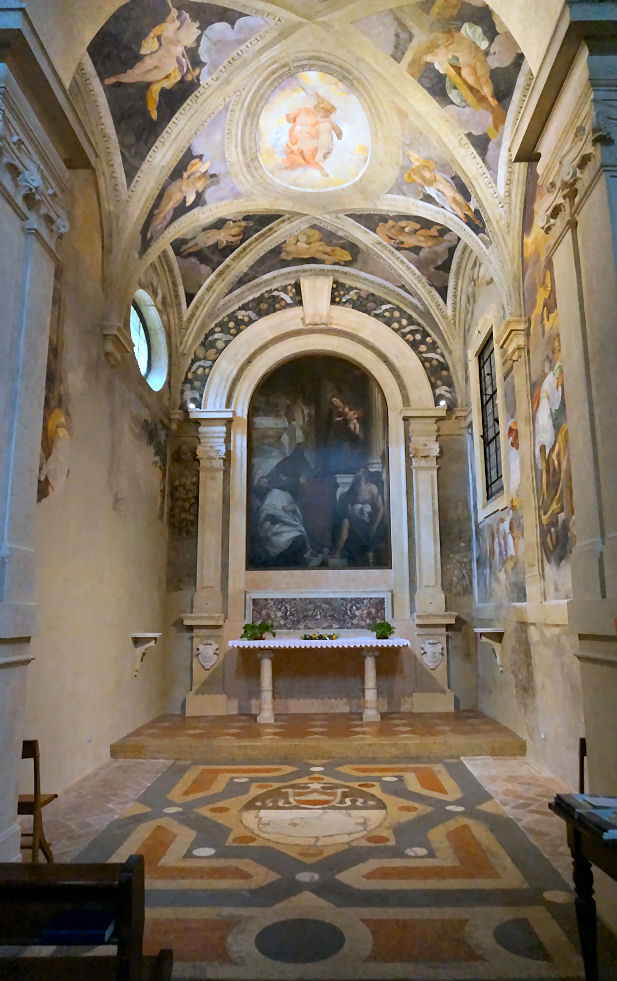 altars either side of the nave
of varying depth. altars either side of the nave
of varying depth.
Of the transept chapels the one on the right, the Marogna,
built for Antonio and Giovanni Battista Morogna and dated 1565, has the
Virgin and Child and Saints John the Baptist and Anthony and Donors by Paolo Veronese
(see right). Veronese was born in the parish of San Paolo in Campo
Marzio, where many painters - the dai Libri, Cavazzola and Farinati - also
lived. The chapel also has some so-so frescoes, illustrating the
stories of Jonah and Elijah on the walls and angels on the ceiling, by
Paolo Farinati, a friend of Veronese who was best man at his wedding and
is buried in this church.
In
the left transept chapel is an impressive San Francesco di Paola by
Domenico Brusasorci, part of a triptych, the rest of which is lost.
On the flat back of the chancel is a Virgin and Child Enthroned with Saints Peter
and Paul (1515) by Giovanni Caroto (the younger brother of the more
famous Giovan Francesco) with the figures in a very steeply
illusionistic portico. Otherwise the chancel just contains a modern altar and two
20th-century paintings. The sacristy has a Virgin with Saints Anthony and Mary Magdalene by Francesco Bonsignori.
The central right-hand chapel has a likable family group of the Virgin and Child
with Saints Anne, Joseph and Joachim by Girolamo dai
Libri, called the Giuliari Altarpiece. Two members of the commissioning Baughi
family are in the foreground gazing up. It has the artist's characteristic
branches of lemons, the lemon being symbolic of fidelity and hence, we're
told, of the Virgin Mary.
The middle chapel on the left has a darkened 1588
Virgin and Child and Saints Nicholas of Bari and Francis by the
already-mentioned Paolo Farinati.
On the right wall of the next chapel
along is a somewhat flat and precise copy of Farinati's Deposition by
his son Orazio.
Lost art
A Virgin and Child with Saints Anthony Abbot and Mary Magdalene,
probably by Francesco Bonsignori, is now in the Castelvecchio.
Opening times
Monday - Friday 8.00 - 11.30, 4.00 - 7.00
Saturday 8.00 - 7.00 Sunday 8.00 - 12.00
A group called Verona Minor
Hierusalem staffs touristic visit times for this church, and
four more nearby. The times they publicise for this church are
Saturday 10.00 - 5.30
|
|
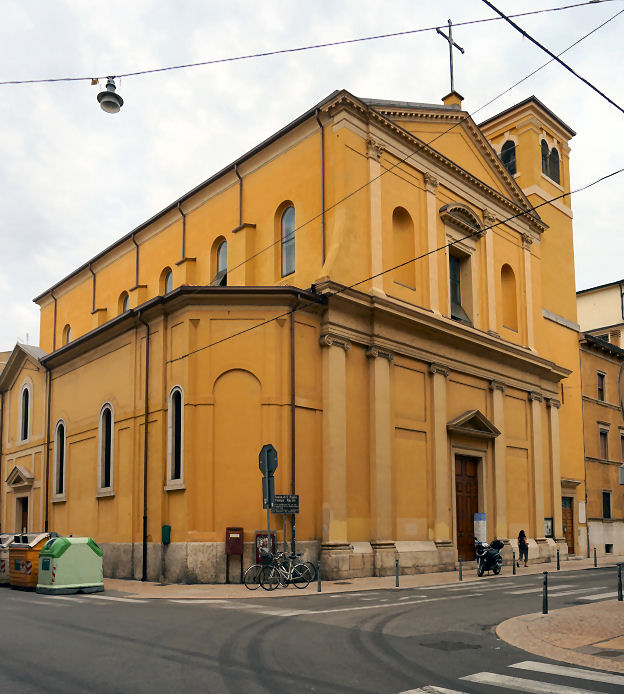
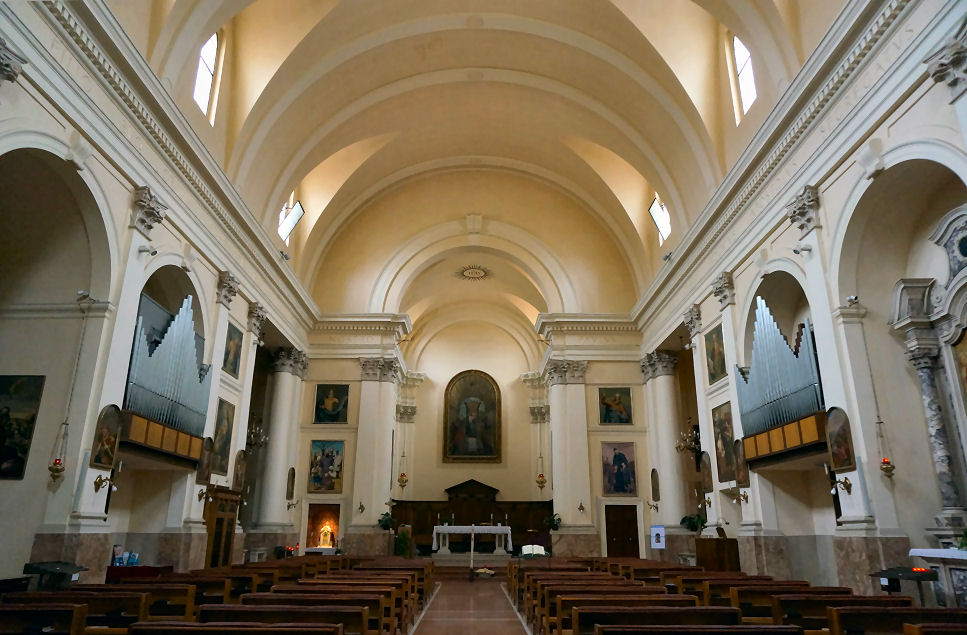
|
|
San Pietro in Monastero
Via Giuseppe Garibaldi |
|
San Pietro Incarnario
Piazzetta San Pietro
Incarnario |
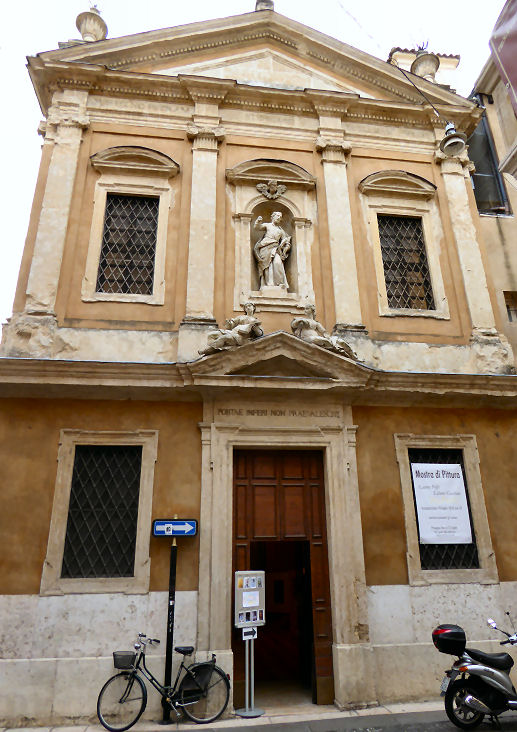
History
Was a Benedictine church in 1147. Had/has an Annunciation by
Paulo Farinati.
Deconsecrated and currently used for art exhibitions.
Opening times
Wednesday to Sunday 10.00 - 1.00,
3.00 - 7.00
But this may be reliant on an exhibition being on. |
|
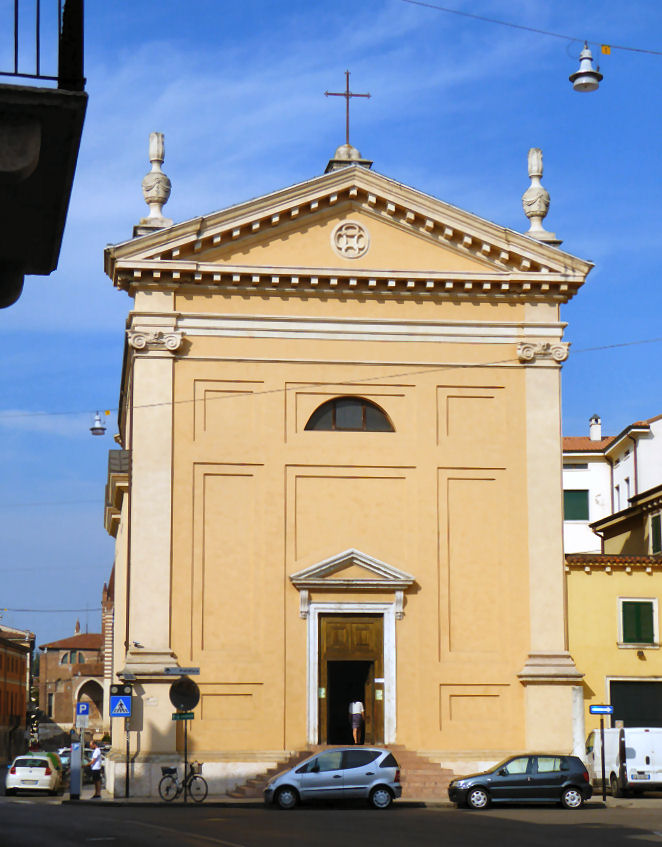
History
Founded in the 10th century on the site of a plague pit, hence carnario, by the Marchese Milone, in an area then
on the outskirts of the city. The first documented mention is in Milone's
will, dated 10th of July 955. Several rebuildings, the last in the 18th
century. Following bomb damage during WWII the facade was rebuilt further
into the church and two of its six side chapels (damaged by the bombing)
were thereby lost. Now used by a Romanian Orthodox congregation.
Interior
Today it's an aisleless box. The crypt contains remains of the earlier
church, including a fresco of the Crucifixion which may date (experts argue) from the 10th or
11th (or 13th) century. Works by Brusasorci?
Campanile
14th century
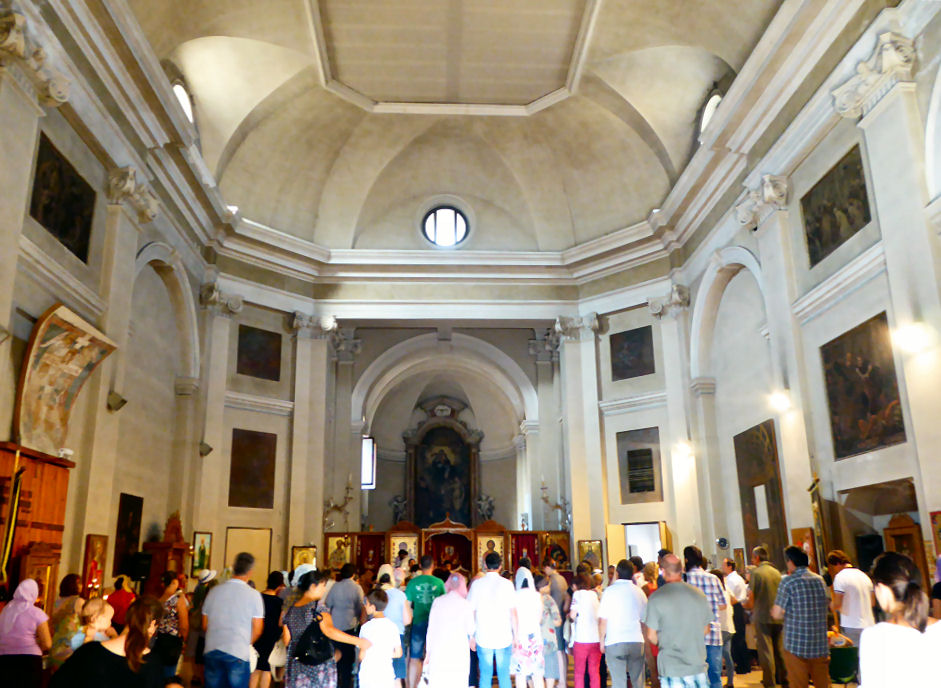
|
|
San Pietro Martire
San Giorgetto
Via Abramo Massalongo |
|
History
Built before 1283, a frescoed inscription above the entrance
records consecration in 1354. It was given as a church and mausoleum to
Teutonic Knights who had the year before helped Cangrande
II della Scala defeat a plot to overthrow him lead by his half-brother
Fregno. The dedication to Saint George was changed to Saint Peter Martyr in
1424 when the church was given to the Dominicans, but locals are
still said to call it San Giorgetto.
French occupation left its marks with burn patches and bullet holes but the
building was returned to the Franciscans until 1806, when it became the
oratory of the Royal LycÚe and Boarding School established in the convent
of Saint Anastasia. It was at this time that a coat of lime was applied
over the frescoes, with the still-visible chisel marks made to make it stick. In
1875 the frescoes were discovered and restored, but the the restoration practices of
the period resulted in further losses to the paint surface.
In the early 20th century it fell out of use and remained closed until the
mid-1970s when the city government intervened to repair damage from damp.
In 1994 restoration of the frescoes was undertaken, and between 2004 and
2009, with the help of Legambiente, whose volunteers staff the open days.
Exterior
There's a funeral
monument of Bavarino de' Crescenzi (1346) on the facade, and Gugliemo di
Castelbarco's funerary tomb, considered the prototype of the Scaliger
tombs, is on top of the arch between the church and Santa Anastasia.
Interior
A single nave with 14th and early-16th century frescos. The Teutonic
Knights commissioned most of the frescoes in the late 14th century. The
three walls in the nave consist of a row of vegetable motifs, under
which is a row of coats of arms of the knights. The larger funerary panels
below represent the dead knights with saints.
15th century votive panels of the 15th commissioned by the Lay Brotherhood
of Saint Peter portraying their patron. The first of these on the
right-hand wall, nearest the presbytery, is by Giovanni Badile, the larger
one to its right, past the plaque, is by Turone di Maxio. The back wall
has two of the earlier funerary scenes with knights, by Bartolomeo Badile,
to the left of the door. To the right of the door is an anonymous funerary
scene and one of the later a Saint Peter panels, by Giovanni Badile
(c.1424).
On the left hand wall
there are two funerary panels by the Second Master of San Zeno, them,
after the first door a throne and coat of arms fragment by Giovanni Badile
(c1438). After the second door are a Virgin and Child Enthroned with
Saint John the Evangelist by Turone di Maxio (1345/75) and Saint
Peter Martyr by Giovanni Badile (c.1437) (see right).
In the presbytery (see below) - a 1354 Crucifixion by the Second Master of San
Zeno. Above is an allegory of The Annunciation by Falconett0 of
1509-15, commissioned by Hans Weineck and Kasper KŘnigl (both portrayed in
the fresco) two advisors to the Habsburg Emperor Maximilian
I.
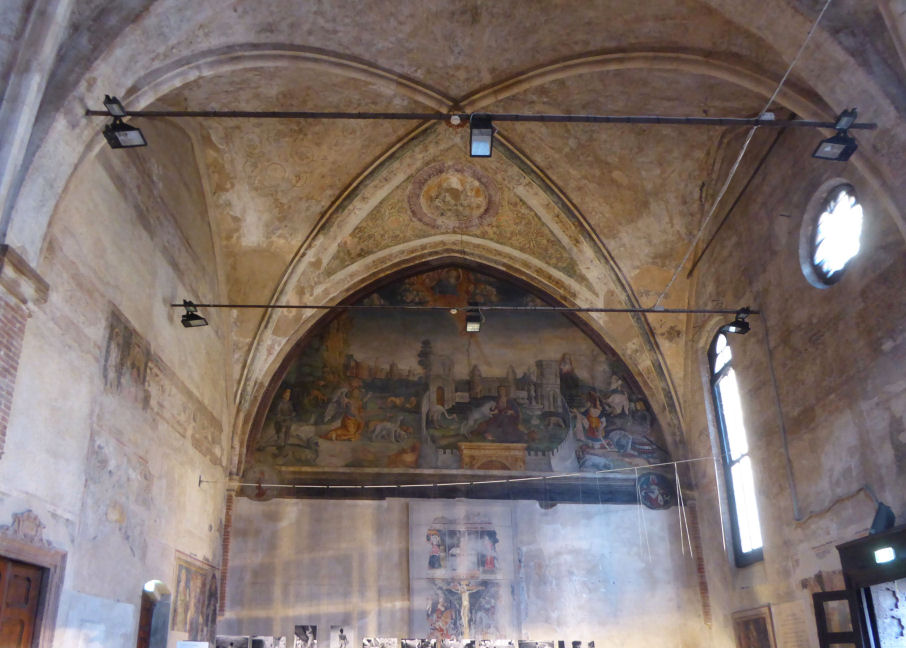
Lost art
Signed by Giovanni Badile, the Virgin & Child with Saints
Anthony, George, James, Peter Martyr, Zeno and Mammas, known as The Aquila
Polyptych (see right) went to the Castelvecchio in 1812. It is known as the Aquila
Polyptych because of a black eagle in a gold frame which used to to be
on the frame. It may previously have been in Sant'Anastasia.
|
|
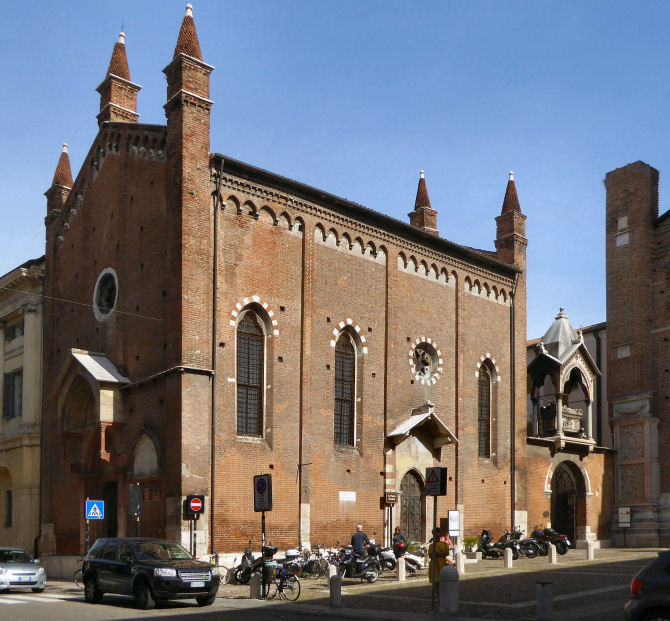
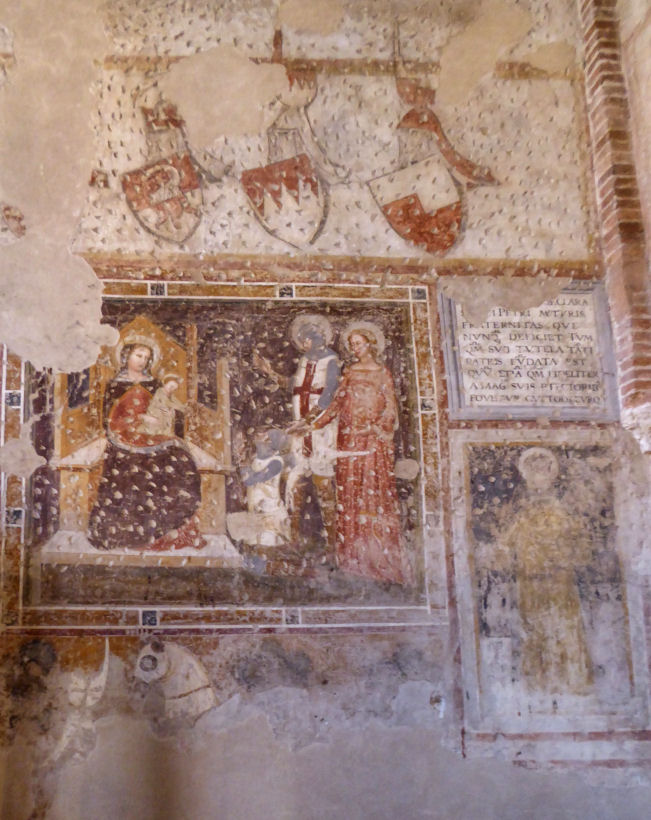
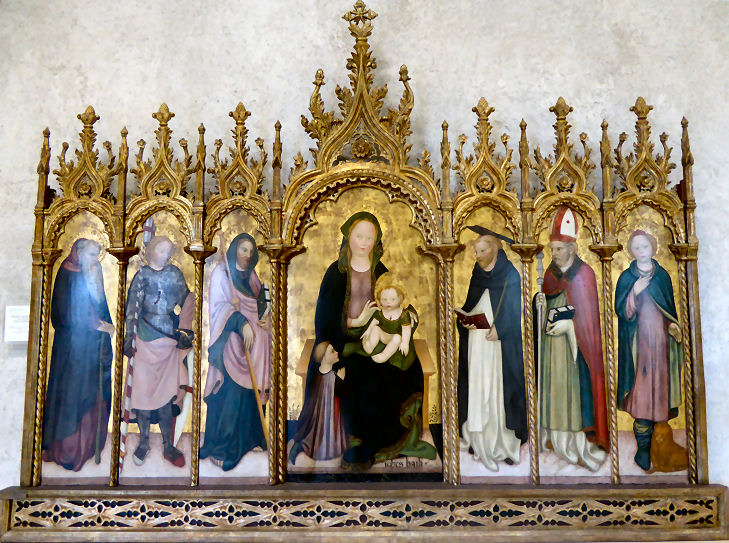
|
|
San Pietro Martire
Via Sant'Alessio
|
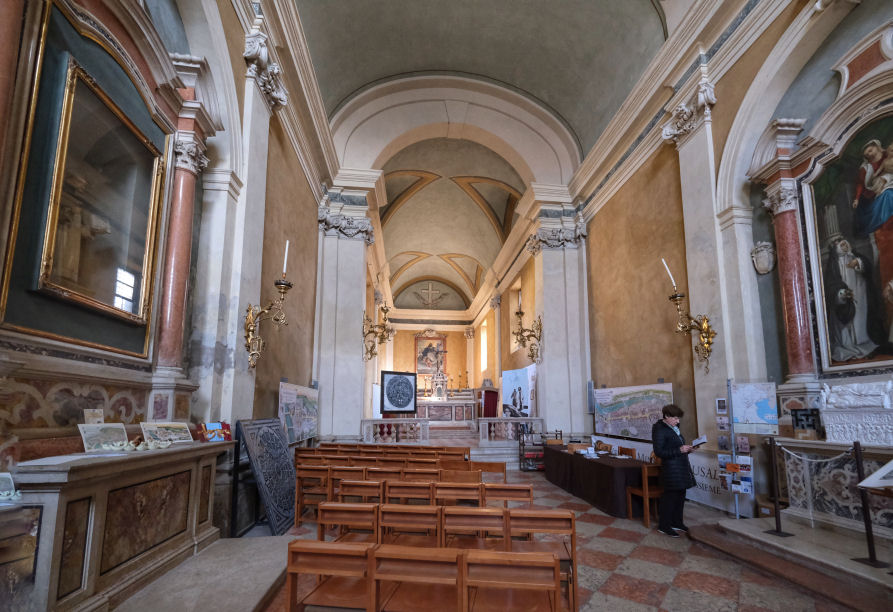 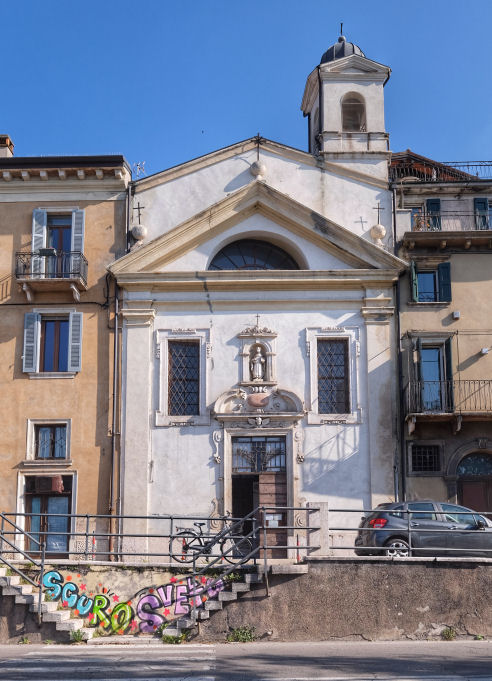
History
Bishop Sebastian Pisani on April 28, 1656 blessed the first stone of the
church of San Pietro Martire, erected on the ruins of named saint's birthplace
A group called Verona Minor
Hierusalem now staffs touristic visit times for five churches near
this one, with this church being used as their HQ, as you can see in the
photo right.
Opening times
The HQ is advertised as open Thursday
to Sunday 9.30 - 6.00 but I advise trying on a Saturday, when I was lucky,
as it's their major staffing day, and they seem to be volunteers.
|
|
San
Silvestro
Vicolo San Silvestro
|
|
History
The original church here was built in the mid-12th century in Romanesque
style, with a nave and two aisles. The church and monastery passed to the
Benedictines in 1523. Rebuilding between 1540 and 1557 and
again in the 1720s, by Lodovico Perini. This last rebuilding formed the
interior which has survived, with a single nave.
The church and attached
Benedictine monastery were suppressed on July 28, 1806, and set for
demolition and/or use as a military warehouse. Knocked about by later
restorations and bombing, the church is now deconsecrated, was used for art exhibitions
for a while, but is now a bank. The adjoining monastery is now luxury
apartments.
Lost art
The Virgin of the Cherubim (Madonna dei Cherubini)
of 1487 (see below) by Antonio Badile
II and a 15th-century Crucifix with Saints Peter and Paul, both in
the Castelvecchio.
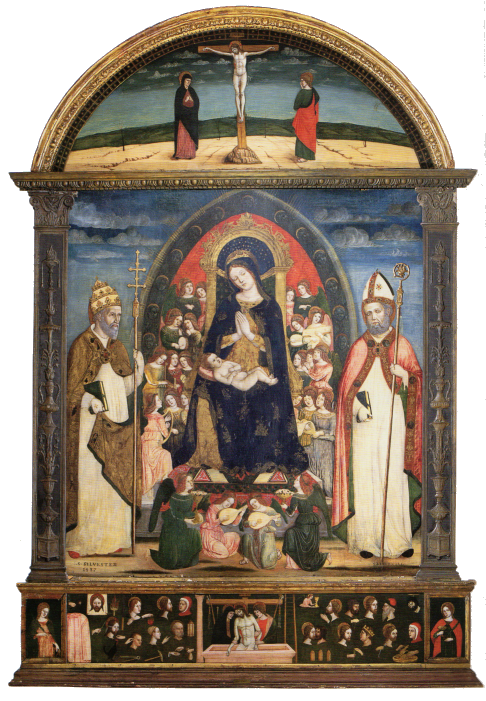
|
|
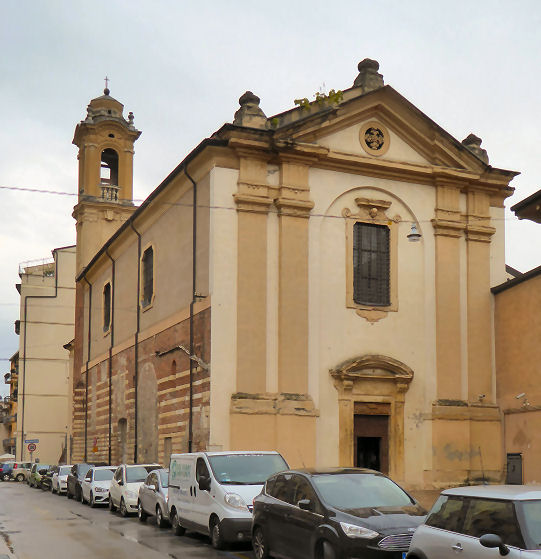
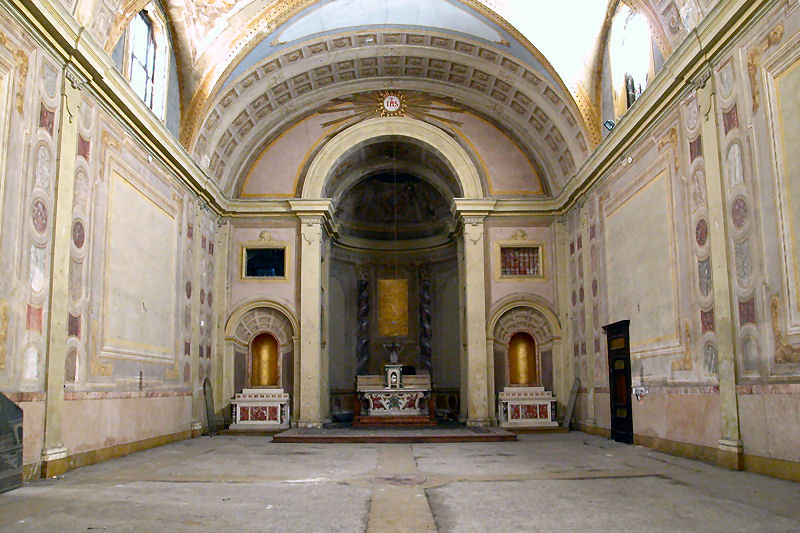
|
|
San Tomaso Cantuariense
San Tomaso Becket
Stradone San Tomaso |
History
The
present church was built in the 15th century by Carmelites to replace
two earlier churches, one dedicated to Saint Thomas Becket (consecrated
May 22 1316), the other to the Annunciation (consecrated in 1351). This
new church was itself consecrated on September 22nd 1504. At this time
the altar was also rebuilt. It is said to have housed not only the
relics of Veronese saints like St. Ursula, St. Martin and St. Benigno
but also the skull of St. Thomas Becket (or three teeth and the frontal bone as
is elsewhere claimed). The church also contains the tomb of Giovan
Battista Beket Fabriano, who claimed kinship with the saint.
The chancel is all that was achieved of a reworking of the interior to
designs by Michele Sammicheli (1545-1550). He died before the work could
be completed and is buried here. A set of his drawings for a later phase
mysteriously disappeared too.
At a mass on the Wednesday after Easter in 1572 most of the wall to
the right of the high altar collapsed, killing thirteen and wounding many
more. The was rebuilding and
reconsecration in 1679. In 1708 lightning struck the 15th century
campanile which was swiftly rebuilt. In 1796 the church turned into French
military hospital by Napoleonic soldiers In 8 June 1805 Napoleon evicted
the Carmelites who took refuge in various Venetian monasteries. The
convent was used as a barracks and then a military court with prison
cells. When the French left the church was reopened for worship after
renovation work and the repair of the damage done by the soldiers. The
church returned to parish use in 1836 but in 1859 the complex was again
deconsecrated and used as a military warehouse for straw and fodder vary,
until 1867 when the church was again reopened for worship. Damaged during
the flood of 1882 - markers on the wall in the now-enclosed cloister
corridor shows the levels reached.
Fašade
The fašade remains incomplete. The doorway was
transferred here from the church of Santa Maria Mater Domini in Valdonega.
Interior
A tall aisleless nave with a wooden ceiling painted with trompe
l'oeil coffering. Four shallow unmatching chapels each side. The triumphal arch in front
of the almost-transept has the Four Evangelists in the dome. Sammicheli's shallow
undecorated apse is flanked by two chapels.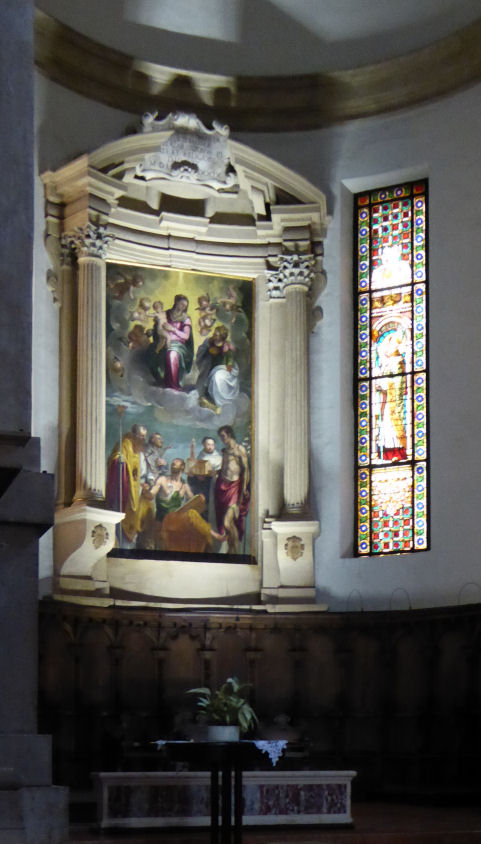
Along the left wall the first and third altars have works by Paolo
Farinati, both depicting the Virgin and Child in Glory with Saints
- Antonio and Onofrio (1569) in the first, Alberto and Jerome
unframed in
the third. Between them Saints Peter, John the Baptist and Paul by
Torbido (Francesco Moro). The Bonatti organ of 1716 (at the ends of the
almost-transept arms) is known to have been played by the 13 year old
Mozart, on the 27th of December 1769.
In the apse The Virgin in Glory with St Anne, with Saints John the
Baptist, Cyril, Thomas Becket and Alberto below of 1579 by Felice
Brusasorci (see left).
The chapel to the right has a painted wooden crucifix of the
14th century brought here from the suppressed church of Santa Maria della Disciplina (now the Vittoria cinema). The chapel to the left has, in the
lunette above the altarpiece, a damaged painting of The Eternal
Father by Antonio Balestra.
The right wall's second altar (after the tomb of Michele Sanmicheli)
has the striking Ecstasy of Mary Magdalene by Alessandro Turchi
(Orbetto) of 1604, the third altar has
a pretty baroque Annunciation by Ballestra, recently conserved for
an exhibition devoted to the artist at the Castelvecchio in 2016/17 to
celebrate his 350th. In the the fourth, dedicated to San Rocco, is the
highlight Saints Rocco,
Sebastian and Job (all looking very classical and muscular) probably painted at the
time of the plague of 1510, by Girolamo dai Libri.
All the altars are nicely lit.
Cloister
Through a door in the right aisle is a now-enclosed cloister
with frescoed lunettes (see right), by Bernardino Muttoni, the impressive wall tomb
of the Grifalconi family and a
small sacristy chapel.
Lost art
A tomb of the Zanchi family is in the Castelvecchio, as is a Descent from the Cross by Liberale da
Verona, a panel from a larger altarpiece.
Opening times
8.00-12.00 & 4.00-7.00
A group called Verona Minor
Hierusalem staffs touristic visit times for this church, and four more
nearby. The times they publicise for this church are
Saturday 10.00 - 5.30
Bibliography
Luca Fabri Chiesa di San Tomaso Cantuariense Verona 2008
For sale in the church.
|
|
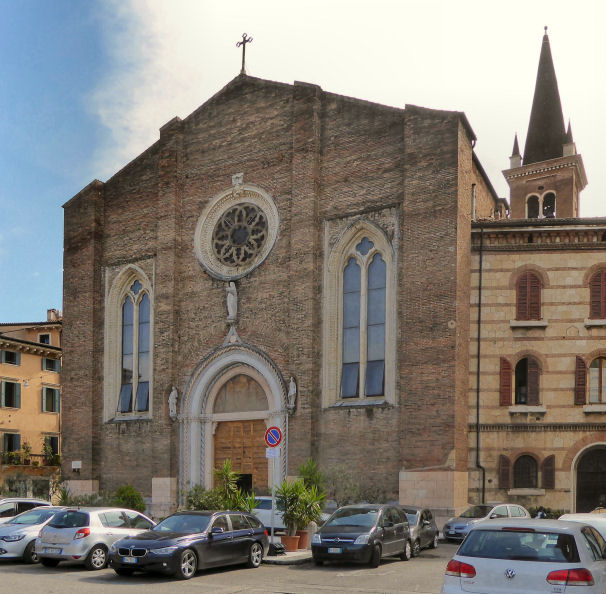
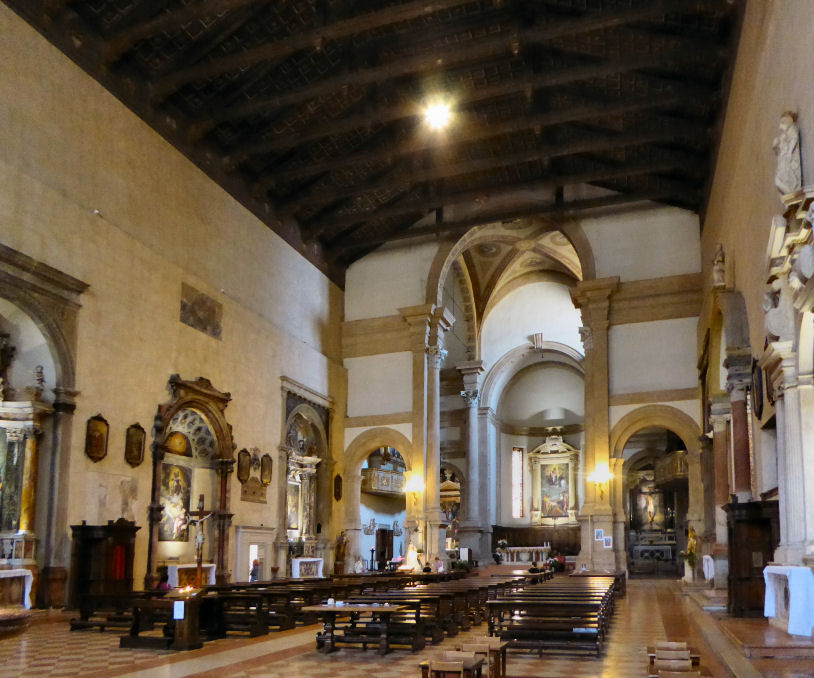
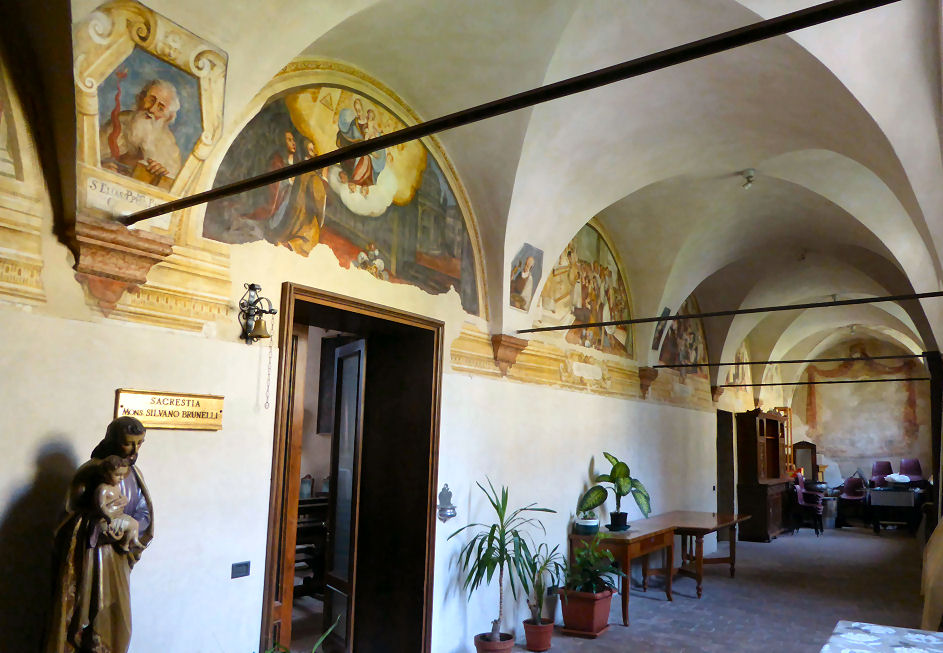
|
|
San Tomio
Via Giuseppe Mazzini |
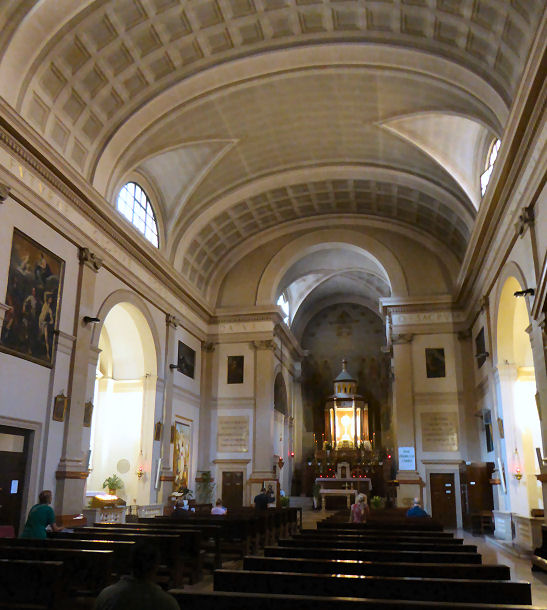
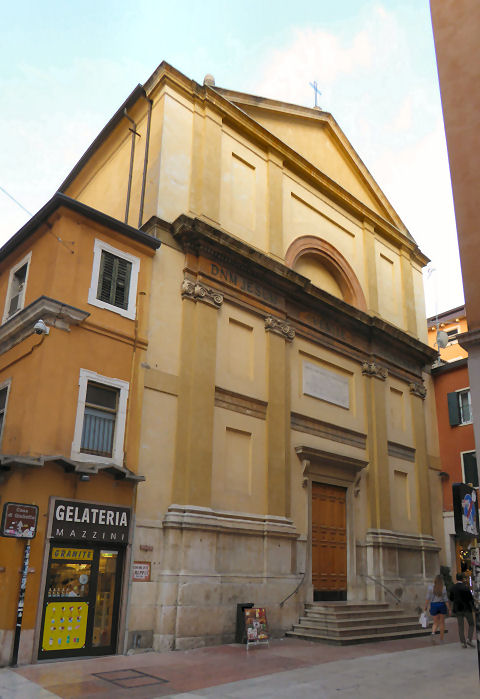
History
Said to have been built on the site of a Roman temple.
The local guild of cheese makers were
patrons. An altarpiece here is said to show San Mammaso, their
patron saint, sitting in front of the hut in the forest that he was
banished to, surrounded by cheeses, which dairy product he is said to have
invented, but I've never been able to find it.
Interior
Aisleless, restrained baroque with
what might be called a
depressed barrel-vault ceiling. Three chapels on the right, the two on the
left have the side entrance between them. The flat-backed apse has a
modern fresco on the back wall, behind a complex high altar. The organ
loft on the back wall has a huge canvas above. There are inset
painted panels high up nearer the apse, and one lunette shaped in the
apse. An excess of confessionals - five - for such a small church.
Lost art
The Circumcision of Christ by Claudio Ridolfi, is now in
Castelvecchio. It is said that the subject matter may have been thought
appropriate for a church on the edge of Verona's Jewish ghetto.
A polychromed marble sculpture of the Virgin and Child, now in the
MET New York.
Opening times 9.00-12.00 & 4.00-7.00
|
|
San Zeno
Piazza San Zeno |
|
This church has its own page
|
|
San Zeno in Oratorio
San Zenetto
Via San Zeno in Oratorio |
|
History
Built in what was a Roman cemetery area, this church was probably built
over a mausoleum - the source of two Roman panels decorated with a Satyr
and Cupids, used in the construction and now preserved at the Malkiano
Lapidary Museum. The apse has a 1st century AD curved relief inserted
upside down in the outside wall. Tradition says that the body of Saint
Zeno was first kept in a church outside the Roman city walls. It is unlikely that San Zeno in Oratory
was this church, though, since it was prone to flooding due to its proximity to
the Adige and would not have been considered safe. There are references to
an early medieval church, though, dedicated to San Zeno. Saint Gregory the
Great, in his Dialogues, mentions a terrible flood
when the water rose to the base of the church windows whilst Zeno was
preaching, but miraculously
spared the congregation inside (see full quote below).
The first single-nave church was probably built in the Romanesque period
and then enlarged to a double nave during the 1300s. In the medieval
period it was dedicated to San Zeno Orador (Preacher)
and kept this name until the late 16th century. The Romanesque structure
recognisable in the raised apse-end and arch, with the nave dating from
the 1300s. 18th
century statues of Saints Zeno and Peter Martyr by Francesco Zorzi are
perched on the front wall of the churchyard.
Interior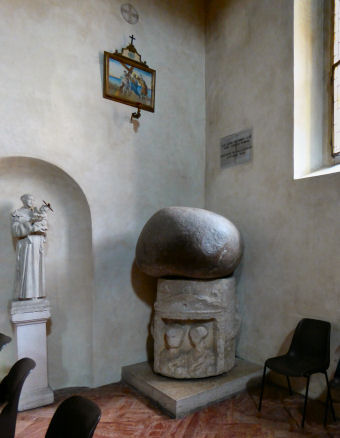
Romanesque with a gothic facade. Proportionally wide with three pinkish
columns separating each aisle from the nave. A timber roof and pale buff
stone walls with exposed brick arches. There are two shallow decorated
chapels in the left aisle, one built for a cloth merchant called Melchiorre
Bassani in 1482. The apse has traces of a 12th century fresco depicting a
crowned woman richly dressed, and a gothic tabernacle in carved relief.
The transept chapels shallowly domed with a deep
decorated dome in the crossing. Many polychrome statues, including two of
Saint Zeno (not looking very African in either) attributed to a sculptor
close to the Master of Santa Anastasia (early 14th century) and, at the
back, the stone on which the saint, according to tradition, used to sit and fish
in the Adige river nearby, sitting on a 1st century Roman funeral altar
with a niche showing busts of a husband and wife. The pulpit has an
Annunciation, also attributed to the Master of Santa Anastasia. A
Crucifixion frescoed on the back wall was recently restored and has
been tentatively attributed to Boninsegna da Clocego.
Quote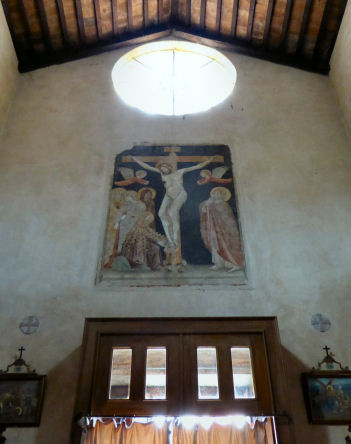
...it came to the very church of the holy martyr* and Bishop Zeno ; and
though the church doors were open, yet did it not enter in. At last it
grew so high, that it came to the church windows, not far from the very
roof itself, and the water standing in that manner, did close up the
entrance into the church, yet without running in : as though that thin and
liquid element had been turned into a sound wall. And it fell so out, that
many at that time were surprised in the church, who not finding any way
how to escape out, and fearing lest they might perish for want of meat and
drink, at length they came to the church door, and took of the water to
quench their thirst, which, as I said, came up to the windows, and yet
entered not in; and so for their necessity they took water, which yet,
according to the nature of water, ran not in: and in that manner it stood
there before the door, being water to them for their comfort, and yet not
water to invade the place.
Saint Gregory the Great, from The
Dialogues
*Zeno's martyrdom is not elsewhere recorded.
Opening times
Daily 9.30 - 11.30am
4.00-6.00pm Monday, Wednesday and Friday
A group called Verona Minor
Hierusalem staffs touristic visit times for this church, amongst others.
The times they publicise for this church are
Saturday 10.00 - 5.30
Bibliography
La Chiesa di San Zeno in Oratorio - Guida Storico-Artistica by
Luciano Rognini, is a booklet available in the church, in Italian.
|
|
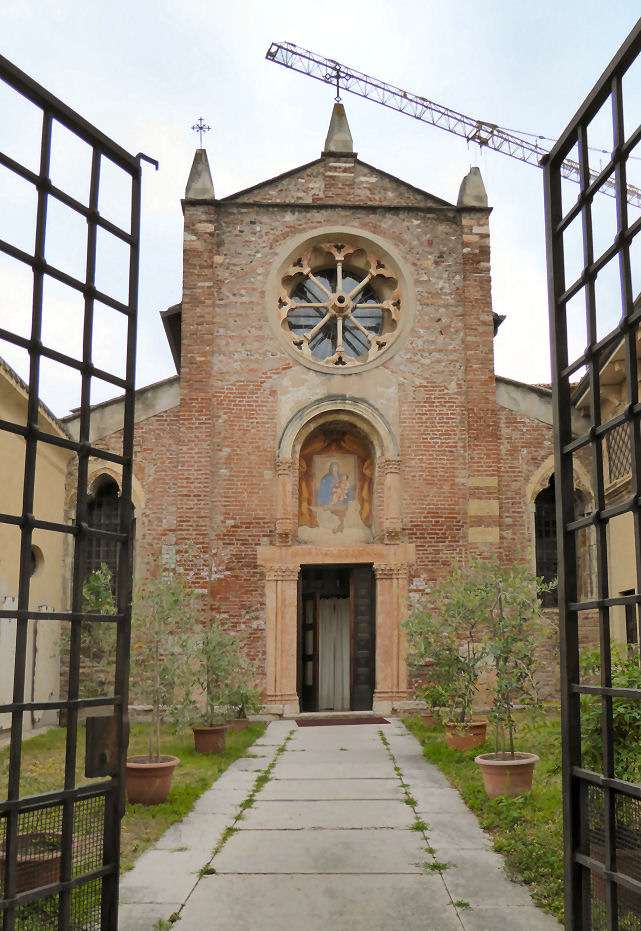
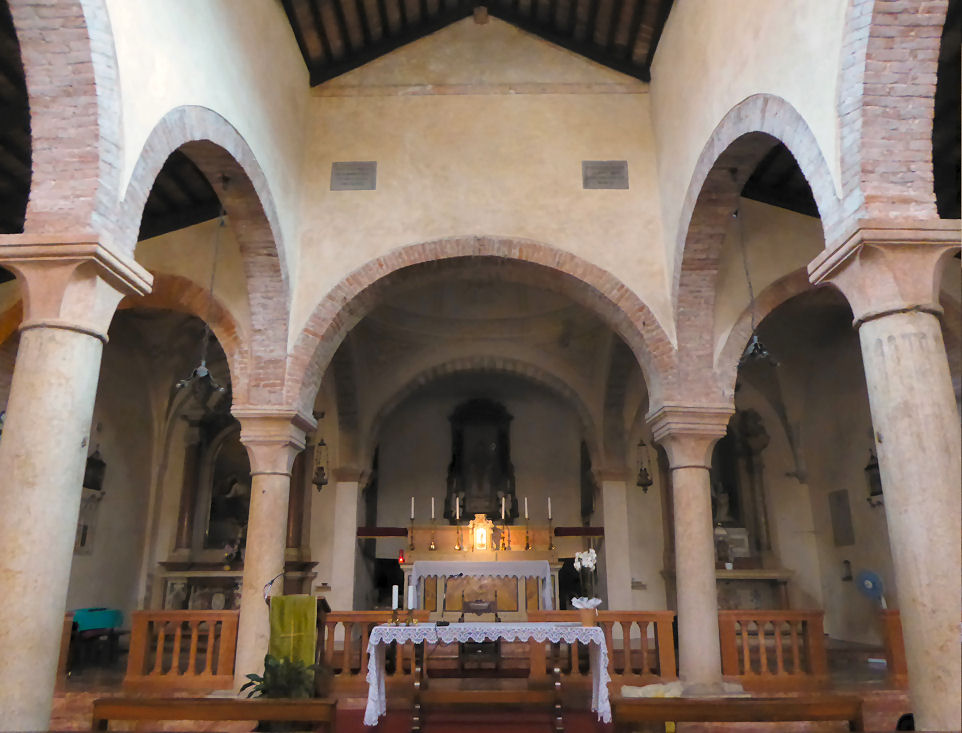
|

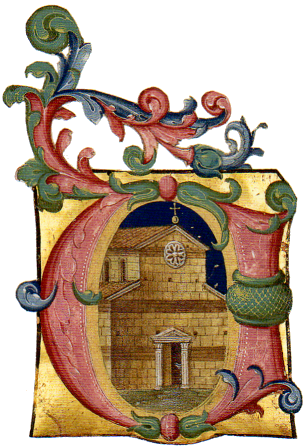









 marry Elena Badile. The altar itself was
designed by Bernardino Brugnoli, a nephew of Sanmicheli, although some
sources attribute it to Sanmicheli himself. On the left of the apse
is Manna by Felice Brusasorci, on the right The Multiplication
of the Loaves is a late work by by Paolo Farinati. Both are a bit forgettable and were
completed by the pupils Alessandro Turchi and Pasquale Ottino. Either side
of the arch is a pair of canvases, once organ shutters, of the Annunciation
by Giovanni Caroto from c.1508,
he being the younger brother of the more famous Giovan Francesco.
marry Elena Badile. The altar itself was
designed by Bernardino Brugnoli, a nephew of Sanmicheli, although some
sources attribute it to Sanmicheli himself. On the left of the apse
is Manna by Felice Brusasorci, on the right The Multiplication
of the Loaves is a late work by by Paolo Farinati. Both are a bit forgettable and were
completed by the pupils Alessandro Turchi and Pasquale Ottino. Either side
of the arch is a pair of canvases, once organ shutters, of the Annunciation
by Giovanni Caroto from c.1508,
he being the younger brother of the more famous Giovan Francesco.









 The crypt
The crypt





 Interior
Interior













 altars either side of the nave
of varying depth.
altars either side of the nave
of varying depth. 























